Human anatomy & physiology was a staple of the Wagner’s educational program during its first thirty years. It was taught almost every semester between 1855 and 1885 by over 15 different professors. One of the more frequently employed professors was Dr. Ralph M. Townsend, who taught at the Wagner beginning in 1868 for almost a decade. Prof. Townsend was a graduate in the 1866 class at Jefferson Medical College where he later became Professor of Anatomy. He was also a Fellow at the College of Physicians of Philadelphia and wrote extensively on medical and surgical practices. 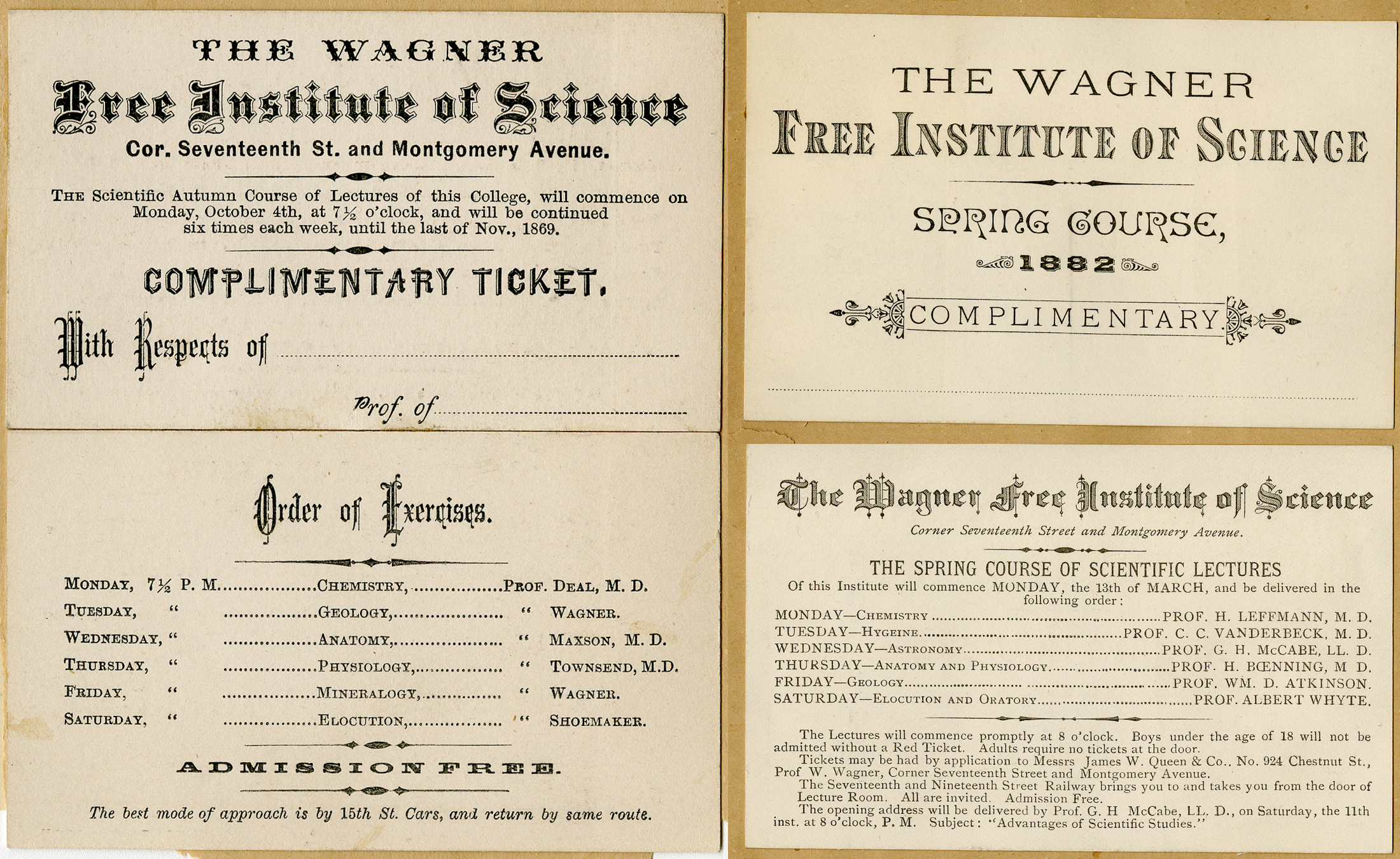 *Course announcements for Fall 1869 and Spring 1882 semesters. From the Scrapbooks of the Wagner Free Institute of Science.* Human anatomy and physiology were the foundation of a medical education, but little of the population could attend these schools. The Wagner’s courses, taught by doctors, provided access to information about the human body that few had access to. And according to an 1868 entry made by William Wagner in the Annals of the Wagner Free Institute of Science, >Human Anatomy & Physiology on Wednesdays attracted larger audiences than any other subjects.  *Plates depicting the muscular system.* * Left: Quain, Jones. A series of anatomical plates; with references and physiological comments, illustrating the structure of the different parts of the human body. Philadelphia : Carey and Hart, 1843. MAIN 611 17. * Right: Cloquet, Jules. Atlas du Manuel d’Anatomie Descriptive. Paris : Béchet, 1825. MAIN 611 19. In medical school, these courses would have been taught using anatomical specimens and human cadavers. These were not available at the Wagner, so courses were illustrated by large, hanging teaching charts and books filled with detailed anatomical illustrations. These illustrations, drawn with such skill and detail, can also be appreciated for their artistic merit.  * Left: Hollick, Frederick. Outlines of anatomy & physiology : illustrated by a new dissected plate of the human organization. Philadelphia : T.B. Peterson, ©1846. MAIN 611 13. * Right: Cloquet, Jules. Atlas du Manuel d’Anatomie Descriptive. Paris : Béchet, 1825. MAIN 611 19. [Temple University-Wagner Fellow](https://sites.temple.edu/templewagnerfellowships/round-one/), Natalia Vieyra, a PhD student in Art History at Tyler School of Art, Temple University, used the Wagner’s collection of 19th century anatomy and physiology texts as part of her ongoing thesis project *Under the Skin: Anatomical Illustrations and the Aesthetics of Medical Knowledge.* Her project delves into the interdisciplinary aspects of these books, considering the intersection of aesthetics, visual culture, science, and medicine. Ms. Vieyra’s project >examines mid-19th century anatomical illustrations, investigating their unique function as both transmitters of scientific information and objects of aesthetic interest, as well as placing them in relation to period discourses surrounding questions of race, gender, and nationalism is 19th century America. In the Wagner’s collection, Ms. Vieyra was especially interested in the Classical imagery used in some of the anatomical illustrations. In reference to the fold-out anatomical diagram in Hollick’s *Outlines of Anatomy and Physiology,* she states, >The figure’s muscular physique, lightly veiled by neoclassical drapery, signifies a conception of vigor and health that is rooted in a Classical past in keeping with the mid-century American identification with Classical Republican values. https://youtu.be/drMNeC34V_o *Video of the fold-out anatomical diagram in Hollick’s Outlines of Anatomy and Physiology.* All books are from the collection of the [Library of the Wagner Free Institute of Science.](http://wagnerfreeinstitute.org/library.shtml) Ms. Vieyra is continuing her research at other libraries and plans on publishing her conclusions in the next year. #### 100% of the SBD rewards from this post will support the continuation of a fellowship program at the Wagner Free Institute of Science. 
The Wagner Free Institute of Science was born out of William Wagner’s love of the natural world, his belief in the importance of science education, and his knowledge that it was not accessible to the majority of the population in the 1850s. Wagner began giving lectures in Conchology, Geology, and Mineralogy in the early 1850s in his own home using specimens from his collections as teaching aids. The popularity of these lectures encouraged Wagner and he enlisted local college professors to expand the subjects offered.  *Tickets to William Wagner's 1850s lectures. From the Scrapbooks of the Wagner Free Institute of Science.* On March 9th, 1855, the Wagner Free Institute of Science was formally incorporated. The Act of Incorporation states: >That the object of this institution shall be the gratuitous instruction in the Natural Sciences such as Geology, Mineralogy, Metallurgy, Mining, Botany, Chemical Agriculture, with their application to the arts and other kindred sciences to all persons. This mission has been carried out in many different ways throughout our history. But the mainstay of our educational programming has always been these free college-level courses offered in the evenings each semester and open to all. 163 years later, we still offer free courses! [Fall 2018 Course Schedule](http://wagnerfreeinstitute.org/edu_adult_sched.shtml)  *Wagner Free Institute Lecture Hall, c. 1900 and a Broadside announcing the course of lectures for the Spring term, 1871. From the Scrapbooks of the Wagner Free Institute of Science.* One of the questions we get asked the most is ... #### Who were the people taking these classes? This is something we are also very interested in. Who was attending Wagner classes and where did they come from? Why did they come? For education, entertainment, both? Did people benefit from taking these course? If so, how? So many questions, but very few ways to find answers. And even more that can’t be answered at all. #### So, where do we look to find these answers? For the first 30 years of the Institute (1855-1885), the only source we have for this type of information is the Annals of the Wagner Free Institute of Science. The Annals are a diary-like account of the operations of the Institute kept by founder William Wagner, but often written in the third person. There are very few statistics, or hard facts present. At best, we get a sense of how William Wagner thought things were going. He often provides a general remark as to the size of attendance, often relating it to the weather. >Weather dry and mild, audience large, including a considerable number of Ladies, the Hall being crowded in every part. or >Weather snowy and boisterous, audience thin. But, this doesn't tell us anything about who the audience was, or even how many people were actually there. It wasn't until the 1890s that attendance records were kept. This began simply with recording the number of people in attendance for each class. Around 1900, the use of roll books expanded to include the names and addresses of students, as well as attendance.  *The Roll Book for Engineering courses taught by Samuel Tobias Wagner. From the Archives of the Wagner Free Institute of Science.* This information helps answer the question of where Wagner students came from. [Temple University-Wagner Institute Fellow](https://sites.temple.edu/templewagnerfellowships/round-one/) Randall Rook delved into to this question during his research and produced a geospatial analysis of Wagner students with respect to Philadelphia’s population trends from 1905 to 1935. Rook gathered addresses from roll books in all subjects offered and mapped them alongside census data from the same years. His conclusion? During the first third of the twentieth century, the majority of students came from the three wards surrounding the Institute's neighborhood.  *Roll Books for Organic Chemistry, Physics, and Zoology. From the Archives of the Wagner Free Institute of Science.* Still, none of this answers the questions of who these people were and why they were taking Wagner courses. Are there answers to these questions out there? Maybe in city records? Maybe a future Wagner Fellow will delve into this research. #### 100% of the SBD rewards from this post will support continuation of fellowship program at the Wagner Free Institute of Science. 
Temple University-Wagner Fellow, Jena Osman, found inspiration in a single specimen of brain coral. See our [previous post](https://steemit.com/museum/@phillyhistory/a-brain-a-maze-no-it-s-coral) to learn more about this specimen and other corals in our collection. This specimen led her down a long and varied path of research that resulted in the creation of an epic poem titled *System of Display,* which was published in Bard College’s literary journal [Conjunctions](http://www.conjunctions.com/about/contributors/jena-osman). Osman’s poems are written by following associative and serendipitous paths. So what was this path that led her from a single specimen to an epic poem? 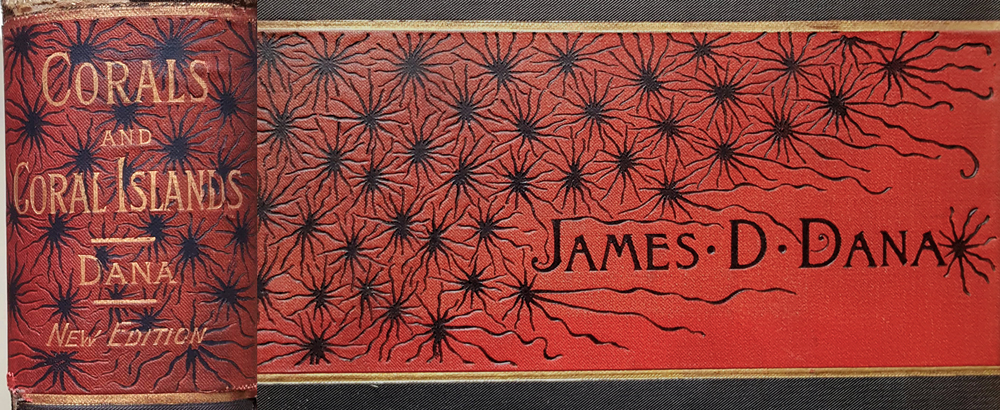 * Coral and Coral Islands by James D. Dana. NY : 1890. [In the Wagner Library](http://pacscl.exlibrisgroup.com:48996/F/L6MYL2DJQVT546GKU5MH1BYU93QVU8A47M9QNNE6GK9CX8FCH1-84289?func=full-set-set&set_number=022415&set_entry=000008&format=999) It all started with a specimen of brain coral from the collection of our founder William Wagner. This immediately presents two paths of research: William Wagner’s history; and corals. Osman’s first question was, had Wagner ever travelled to the places the specimens of coral came from – the Bahamas, the Caribbean, and the South Pacific? In Osman’s research into William Wagner, she learned that in his youth, he worked for the great financier and philanthropist [Stephen Girard](https://en.wikipedia.org/wiki/Stephen_Girard). She discovered that: >Wagner was deeply impressed by Girard’s philanthropic creation of Girard College, and that his gift inspired Wagner’s desire to create a free educational institution for all who had an interest in science. So I was very interested to learn that when Wagner was 20, he was supercargo on a ship named Helvetius, named after the French Philosopher Claude-Arien Helvetius. In 1758, Helvetius published De L’Esprit (On Mind) where he argued that all people have the same ability to learn and that unequal education is the key to inequality. Wagner’s stint as a supercargo was in 1818, which also, coincidentally, was the year that Philadelphia established its first public schools.  * Papers from the [Robert Chambers Collection]( http://hdl.library.upenn.edu/1017/d/pacscl/WFIS_WFIS90015) in the Wagner Archives. Osman’s research path into corals and coral reefs stretched from >19th century understandings of the organisms and reef formation to 21st century confrontations with coral bleaching and the very real possibility of total reef collapse as the oceans warm. She consulted current scientific research as well as historic texts from the Wagner’s library.  * Tableau encyclopédie et méthodique des trois règne de la nature. Paris : 1827. [In the Wagner's Library](http://pacscl.exlibrisgroup.com:48996/F/L6MYL2DJQVT546GKU5MH1BYU93QVU8A47M9QNNE6GK9CX8FCH1-85252?func=full-set-set&set_number=022492&set_entry=000001&format=999) Osman also found in the Wagner’s archives William Wagner’s handwritten lecture on coral reef formation.  * William Wagner's lecture on [Coral Reefs](http://dla.library.upenn.edu/dla/pacscl/detail.html?id=PACSCL_WFIS_WFIS89015) in the Wagner's Archives. #### Her conclusions? Free public education and the world’s system of coral reefs, vibrant and sustainable in William Wagner’s time, now seem somewhat precarious. You can read *System of Display* by Jena Osman in [Conjunctions:69, Fall 2017, pp. 252-265](http://www.conjunctions.com/print/archive/conjunctions69) #### 100% of the SBD rewards from this post will support continuation of fellowship program at the Wagner Free Institute of Science. 
Stony Corals, or hard corals, are the reef builders of the world and exist in many different shapes and sizes. In fact, there are over 3,000 species of stony corals! While the Wagner museum does not have anywhere near 3,000 specimens of corals, we do have an entire case dedicated to them - Museum case 26. Many are from the collection of our founder, William Wagner. And the rest were either purchased or donated between 1889-1899. Temple University-Wagner Fellow, Jena Osman, found inspiration in a single specimen of brain coral that led her down a long and varied path of research and finally to the creation of a poem. So today, we thought we would present a selection of corals similar to the brain coral specimen (#2917 WW). Maybe they will inspire you!  Left: **Maze Coral,** ***Meandrina labyrinthica*** (Bahamas), gift of J.W. Bunting. Accession #3335. Right: **Brain Coral,** ***Diploria cerebriformis*** (West Indies), William Wagner Collection. Accession #2917 WW. Current scientific name *Diploria labyrinthiformis.*  **Symmetrical Brain Coral,** ***Meandrina strigosa*** (Bahamas), in exchange from [Walter F. Webb](https://en.wikipedia.org/wiki/Walter_Freeman_Webb) Accession #8046. Current scientific name *Pseudodiplora strigose.*  Left: ***Goniastraea eximia*** (Tonga Islands), purchased from [Henry A. Ward](https://en.wikipedia.org/wiki/Henry_Augustus_Ward) Accession #400. Current scientific name *Goniastrea retiformis.* Right: **Cauliflower or Brush Coral,** ***Pocillopora,*** William Wagner Collection, Accession #2941 WW.  ***Astraea speciosa*** (Singapore), purchased from Henry A. Ward, Accession #397. Current scientific name *Dipsastraea speciosa.* And my favorite! Next time: more about Jena Osman's reserach. ### 100% of the SBD rewards from this post will support continuation of fellowship program at the Wagner Free Institute of Science. 
When it comes to the dynamics of Steemit, I’m no expert. But I *do* have a good sense of the dynamics of a big-city cultural community. In particular, since the late 1970s I’ve focused on the care and feeding of Philadelphia’s historical assets. --- #### It’s a sector that needs leadership, resources and vision. In other words, it could use a new operating system. --- Forgive my arrogance, but I like to think that occasionally I can glimpse the future. And for some time now, I’ve been looking to the blockchain as the sector's potential gamechanger, possibly even its holy grail. Philadelphia’s history community is a complex and interesting chunk of an even larger cultural landscape. This city has a plethora of archives, libraries, historic houses and museums. (PACSCL, the Philadelphia Area Consortium of Special Collections Libraries, has 38 members.) Many sites are National Historical Landmarks. (There are 67 in the city.) More than institutions, the city is ripe with individual stakeholders in the form of tour guides, collectors, dealers, scholars, visiting academic fellows, preservationists, conservationists, board members, volunteers and, of course, funders. In addition, uncounted thousands of residents in the region live in houses that date back more than a century in more than 100 neighborhoods have names with ties to interesting pasts. (Manayunk! Fishtown! Swampoodle!) It’s a sprawling web of many interlocking communities and focused pods of interest. 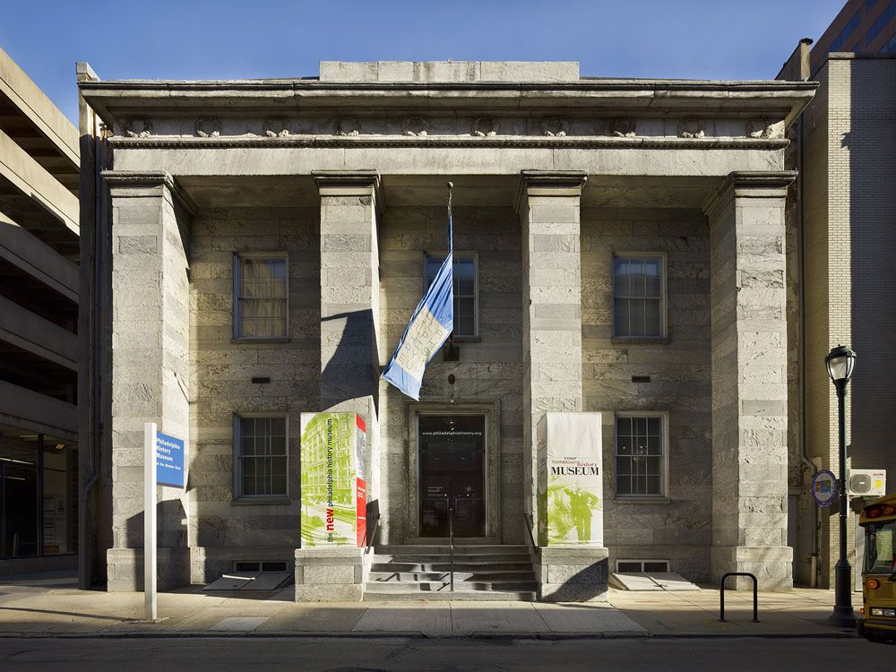 *[Source: The Philadelphia History Museum.]* Now, I’ve seen this sector’s highs and lows firsthand since the 1970s. And it’s pretty clear where its strong and its weak points reside. (For example, consider the recent closure of the Philadelphia History Museum.) There's fragmentation to a point of systemic dysfunction. What seems to have long been missing is a sense of the system as a whole. <center>**[[See my recent oped piece in *The Philadelphia Inquirer*.]](http://www2.philly.com/philly/opinion/commentary/philadelphia-history-museum-atwater-kent-philadelphia-closed-20180709.html)** </center> Some of us who’ve worked in this sector have hoped that there is a theoretical “control room” where the levers of power of the sector’s operating principles might be found. Assuming such a “place” exists, locating it, occupying it, would be a “Eureka!” moment. And once that discovery is made, Philadelphia’s history eco-system could be nudged, even gently re-engineered to improve its functionality, its clarity as a system. #### Things would never quite be the same again. --- Ever since I jumped (or was I pushed?) into Steemit more than a year and a half ago, I thought that I’d maybe stumbled upon this holy grail of history. Ever since, I've wanted to speculate and articulate a few, "what if" scenarios to re-build an engaged hyper-local community that would lead to new models of functionality in every aspect of the sector, from education to stewardship and governance.  *[Source: The Philadelphia Inquirer, Elizabeth Robertson.]* In the last half year, with the help of many others, @phillyhistory, the crypto-experiment has earned 3,800 STEEM in rewards to continue a fellowship program at The Wagner Free Institute of Science, one of the city’s most interesting and challenged historical gems. And now that @phillyhistory is up and running in the hands of Lynn Dorwaldt, archivist/librarian at the Wagner, what is possible for them—what is possible for the larger community? Will the Wagner be able to attract and engage 100, 500 or 1,000 local followers on the Steemit platform? That may not be an unrealistic target. As a cultural destination, the place gets tens of thousands of real-life visitors annually.  *[Source: The Wagner Free Institute of Science.]* Consider what would be possible if the Wagner succeeds in expanding its digital footprint, setting an example for other historical institutions and communities of interest to do the same. What would the impact be? What would the future look like, integrating the blockchain into one city’s cultural landscape? Let’s assume that the onboarding of longtime loyal, interested friends at a place like the Wagner is possible. Let’s also assume a number of other content-rich nodes of Philadelphia history will also want to jump in and stake *their* claim to an expanded online community that, ultimately, will use the blockchain to reconnect the long fragmented critical mass of one city’s historical content. Initially, there’d be essential steps on the learning curve, first implying then demonstrating real, transformative community-wide innovation. Ultimately, the blockchain would help leverage the future of culture in one city. #### Does this approach make sense? --- Or should we skip the step of building a hyper-local digital cultural community online and leapfrog to a media footprint on a global scale? --- <center>*Stay Tuned For More*</center> <center>[](https://steemit.com/@kenfinkel)</center>
### Can Victorian microbiology inspire beautiful jewelry? **The answer is yes!** [Emily Cobb](https://www.emily-cobb.com/fellowship) first visited the Wagner's museum over ten years ago and returned repeatedly finding inspiration in the displays of taxidermied animals. But it wasn’t until she was awarded a [Temple University-Wagner Institute Fellowship](https://sites.temple.edu/templewagnerfellowships/round-one/) that she took the opportunity to explore the materials in the Wagner's archives. She was particularly drawn to the collection of tiny detailed drawings of microscopic organisms and bacteria by the 19th-century biologist [Joseph Leidy](https://en.wikipedia.org/wiki/Joseph_Leidy). 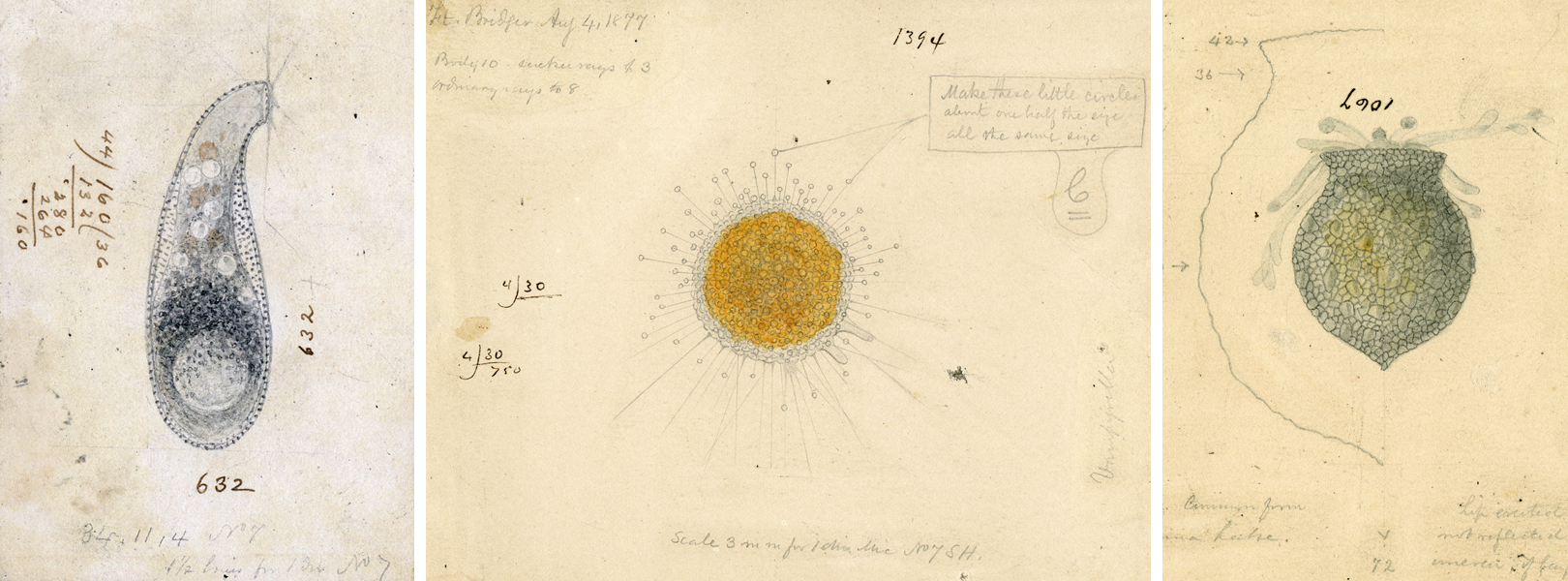 Drawings of microscopic organisms by Dr. Joseph Leidy. From the [Archives of the Wagner Free Institute of Science](http://wagnerfreeinstitute.org/library.shtml) Leidy’s scientific drawings reminded her of technical drawings created by designers, like [René Lalique](https://www.google.com/search?q=lalique+jewelry+drawings&tbm=isch&tbo=u&source=univ&sa=X&ved=2ahUKEwj03ejShd7cAhXHm-AKHc4yCRMQsAR6BAgBEAE&biw=1543&bih=869), for jewelers to interpret and recreate as three-dimensional objects made with precious metals and gems. This inspired her to interpret Leidy’s drawings through the mindset of a contemporary jeweler. In Emily’s words: >The world of science and art often overlap, and the process of creating detailed renderings in both the field of natural science and jewelry design is an inspirational example. Whether these drawings are ultimately presented to an audience in a lecture hall or to a jeweler in their studio, the goal is similar: to produce a drawing or diagram that will describe the particular qualities and characteristics of a specimen to an individual who cannot see the actual thing in front of them. Nevertheless, even extremely detailed scientific and artistic renderings are subject to individual interpretations. Over the course of her fellowship, Emily studied hundreds of drawings from the Wagner's collection. She used a 3D modeling program to transform scans of Leidy's drawings from a single perspective into three-dimensional forms. In this program, she could move the forms around and get an idea of how they could interact with the body as jewelry. Then, using a combination of 3D printed materials, mild making, and traditional jewelry fabrication techniques, she created the following pieces. Each is pictured with the original drawing that inspired it.  ***Difflugia Pseudostome*** - Ring. Gold-plated Brass. Difflugia is a genus of single-cell organisms.  ***Diplophrys Archeri 1414*** and ***Diplophrys Archeri 1415*** - Brooches. Gold-plated Brass, Lacquer. Scientific description of [Diplophrys archeri](https://www.arcella.nl/diplophrys-archeri)  ***Cysticercus T. Solii*** - Necklace. Sterling Silver, Mother of Pearl. T. solium is a species of tapeworm!  ***Cysticercus T. Solii*** - Ring. Sterling Silver, Mother of Pearl. T. solium is a species of tapeworm! What do you think? Would you wear a tapeworm necklace? An Amoeba brooch? What inspires you to create? Let us know. We are always looking for new ways to engage people with historical resources! #### Next time: What does it take to create a poem about corals, William Wagner, and contemporary events? ### 100% of the SBD rewards from this post will support continuation of fellowship program at the Wagner Free Institute of Science. ### Follow the Wagner @phillyhistory
Hello from the staff at the Wagner Free Institute of Science! We are very excited to be part of the Steemit world and to explore the new and exciting ways a cultural institution can add to and benefit from the Steemit community. Many thanks to Temple University's [Center for Public History](https://sites.temple.edu/centerforpublichistory/) and Temple's MLA Program for giving us this opportunity! So ... ### [What is the Wagner Free Institute of Science?](http://www.wagnerfreeinstitute.org/)  *The Wagner Free Institute of Science, 17th and Montgomery Ave., Philadelphia. Left in 1865 and Right in 2005.* Simply put, we are and educational institution and natural history museum founded in 1855 to provide free education in the sciences to the public. But, we are so much more than that! Today we continue to offer free college level evening courses, we offer stand alone lectures on scientific and historic topics, and we have a robust children's education program that furthers our reach into the Philadelphia public schools. On top of that, in 1990 our building and collections were designated a National Historic Landmark that we now preserve and interpret as an example of Victorian-era natural history and science education.  #### And why are we here? We will continue to explore the question "What is the Wagner Free Institute of Science" by presenting historic materials from our library, archives, and museum collections. How can these historic materials be used to explore our history? What other areas of research can be explored? What new and creative projects can be created from this research? We look forward to engaging with the Steemit community in thinking about these questions in new and exciting ways! Our goal is to be able to continue the [Temple University-Wagner Free Institute Fellowship Program](https://sites.temple.edu/templewagnerfellowships/round-one/) with funds earned here. This fellowship program was created to stimulate opportunities for Temple faculty and graduate students in the creative and academic disciplines to work with the historic collections at the Wagner Free Institute of Science. Over the next couple of weeks we will present research projects completed by the 8 first year fellows. #### Next time: Can Victorian microbiology inspire beautiful jewelry? ### 100% of the SBD rewards from this post will support continuation of fellowship program at the Wagner Free Institute of Science. ### Follow the Wagner @phillyhistory
As promised, the semester-long crypto-experiment conducted by graduate courses at Temple University's [Center for Public History](https://sites.temple.edu/centerforpublichistory/) and Temple's MLA Program has concluded with an allocation of the rewards pooled by this and 15 other accounts. (To see a summary of this 15-week effort that produced nearly 300 posts and drew more than 10,600 upvotes [click here](https://steemit.com/projects/@phillyhistory/semester-summary-at-steemit-u-what-have-we-accomplished).) It all started back in January when we set out to "explore history and empower education." [Click here](https://steemit.com/introduceyourself/@phillyhistory/announcing-the-first-steem-powered-university-course-mining-the-year-1918-at-temple-university) to learn more about the origins of the project. ## Drumroll Please... --- After much exploration and consideration, we are pleased to announce that this account plus all of its assets, which includes more than 3,847 STEEM, will be transferred to the Wagner Free Institute of Science to continue the [Temple University-Wagner Free Institute Fellowship Program.](https://sites.temple.edu/templewagnerfellowships/round-one/) This project, which is now in hiatus, got off the ground in 2016-2017 with a $12,000 seed grant from Temple University's Presidential Humanities & Arts Research Program. Its goal? To stimulate opportunities for Temple faculty and graduate students in the creative and academic disciplines to work with the Wagner Free Institute of Science and it’s collections. Eight projects were funded, the success of the program was apparent to all involved, and the question soon became, where could funds be found to continue this fellowship program? The answer: pair up with the power of Steemit, where valuable content plus community interest equals currency. ## What is the Wagner? --- [The Wagner Free Institute of Science](http://www.wagnerfreeinstitute.org/) at 17th Street and Montgomery Avenue in Philadelphia is a museum and educational institution that remains nearly unchanged since the nineteenth century. Its free public education courses on science, after more than 160 years, make it the oldest program devoted to free adult education in the United States. The Institute was formally incorporated in 1855 and designated a National Historic Landmark in 1990. Its museum, library and archive constitute a living vintage resource and a unique cultural destination. 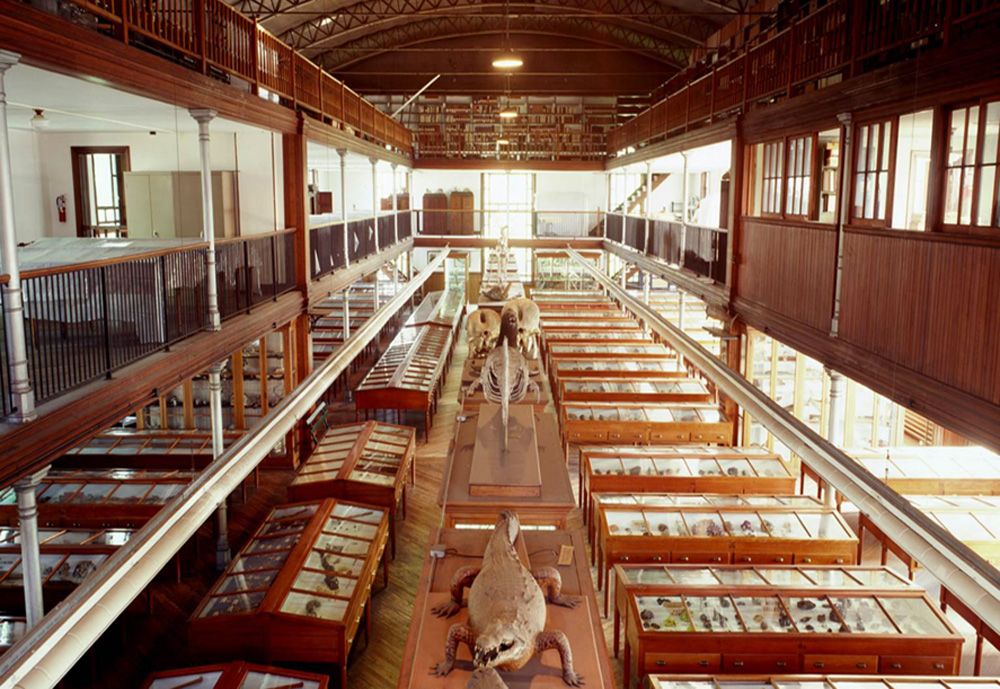 *Wagner Free Institute of Science. The Gallery.* ([Image Source.](http://www.wagnerfreeinstitute.org/)) The Wagner’s commitment to experience and object-based learning makes it an especially strong partner for Temple University. 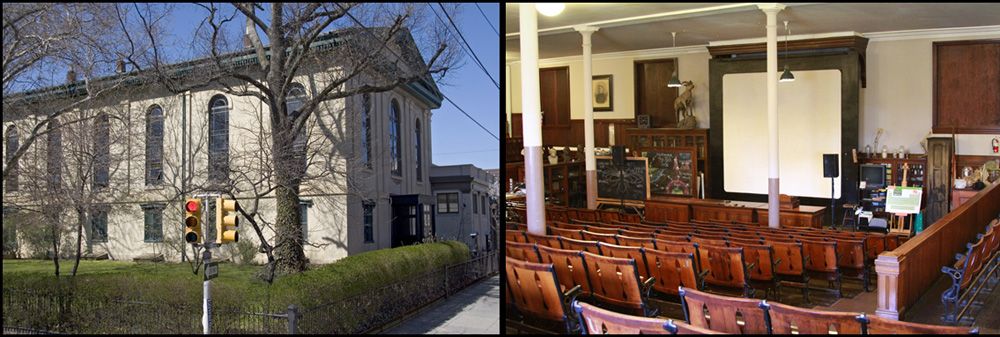 *Wagner Free Institute of Science. Exterior and Lecture Hall.* ([Image Source.](http://www.wagnerfreeinstitute.org/)) ### Next Time: More about the Wagner and past Temple-Wagner fellowships. <sup>100% of the SBD rewards from this post will support continuation of fellowship program at the Wagner Free Institute of Science. --- <center>[](https://steemit.com/@phillyhistory)</center>
As we boasted last time, the @phillyhistory project was brought to life by 15 students who, along with @phillyhistory, published 297 posts in 15 weeks drawing 872 comments and 10,647 upvotes. Thanks to @charliehersh, @cheider, @chelseareed, @connellgregg, @dduquette, @engledd, @jfeagan, @gvgktang, @hourofhistory, @johnesmithiii, @landy-yinan, @peartree4, @tmaust, @xiaonanli and @yingchen for making the project come alive. We wanted to highlight a few notable moments. 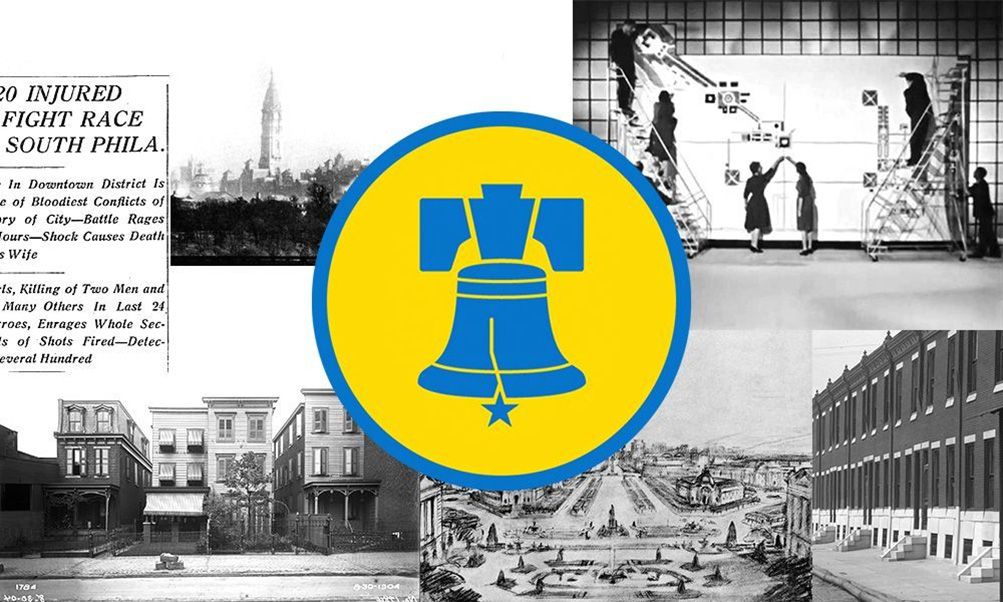 ## The ones that garnered the most attention were: ## 109 Upvotes: [*Arts, Culture, and Philanthropy: The Robbed and the Robbers*](https://steemit.com/history/@cheider/arts-culture-and-philanthropy-the-robbed-and-the-robbers) >@cheider brought to our attention an 1892 *New York Times* announcement of a free “upcoming exhibition” on the Lower East Side that “dripped with disdain, playing up the foolishness of the gesture.” The headline read “East Side Picture Exhibition, Valuable Paintings Which Poor People May Look At,” underscoring the monetary value of the 100 paintings to be exhibited; featuring the insurance value of $150,000. “It attracted 36,095 visitors in a forty-one day run…” ## 81 Upvotes: [*Fair Wages, or Why Steemit Isn't Right for Cultural Institutions...Yet.*](https://steemit.com/explore1918/@tmaust/fair-wages-or-why-steemit-isn-t-right-for-cultural-institutions-yet) >@tmaust cut loose with a provocative post that created quite a stir with 81 upvotes and 16 comments from 8 individuals totaling 2,500 words, including Steemians not enrolled in the course. (Thank you @natureofbeing, @remlaps and @hansikhouse.) “If the blockchain becomes part of mainstream life," wrote @tmaust, "of course museums should embrace it. However, it also feels like the blockchain hype is based on a fragile market... That's not a healthy market. IF cryptocurrency is ever able to support a living wage, raise money, and provide a benefit as a content management tool... it could prove to be a boon for cultural organizations. But that potentiality would come with its own ethical quandaries and we are not there now.” ## 79 Upvotes: [*1918: Achille-Claude Debussy-- The Imaginative World Is The Only Real World*](https://steemit.com/debussy/@yingchen/1918-achille-claude-debussy-the-imaginative-world-is-the-only-real-world) >From @yingchen: Debussy’s “music was completely different from other musicians, and he didn't often use the major and minor scales used in traditional classical music. Sometimes he would go back to the quaint old tunes of the early church music. [His] favorite scale had six tones and no half-tone, so his melody was distinctive from any past music. His chords were even weirder. He built his unique "dream world" by using his favorite diatonic scale, as he said, ‘The imaginative world is the only real world’.” ## 59 Upvotes: [*20th Century Solutions, 21st Century Problems?*](https://steemit.com/nonprofits/@gvgktang/20th-century-solutions-21st-century-problems) >@gvgktang on the Historical Society of Pennsylvania: “After a deficit was incurred in FY13, the organization was able to recoup the loss and have positive net balances in FY14 and FY15. Overall staff costs declined by 2.6% over those 3 years, but the CEO salary rose by 21.9% in the same period. … The Society hopes to maintain its current levels income and expense, including staff funding: despite rumors that it might “have to ‘go dark’ for a period of time.” ## 59 Upvotes: [*Philadelphia History Museum(s)](https://steemit.com/philadelphia/@charliehersh/philadelphia-history-museum-s) >Responding to a reading from the mid-1990s, *A Vision for a Historical Center in Philadelphia,* @charliehersh points out that “a better alternative would have been to support” what’s in place. “The article cites a fundraising goal of $50M, including a $20M endowment, and that money could instead be used to create a framework that could encompass all existing historical institutions, to make them a more cohesive network instead of disparate organizations.” ## 54 Upvotes: [*Collectors in China: Art Lover and Tricky Investor*](https://steemit.com/explore1918/@landy-yinan/collectors-in-china-art-lover-and-tricky-investor) >@landy-yinan tells us that art collecting “has become a trend among Chinese second-generation rich kids” who are both wealthy and educated. They are “different from older generation Chinese collectors who lacked “knowledge of art and [were] mostly dependent on art brokers to search for investing targets.” These “young investors have passion” for the arts and are redefining the market. ## 50 Upvotes: [*The Row Home Museum: Letter of Intent*](https://steemit.com/loi2018/@tmaust/the-row-home-museum-letter-of-intent) >@tmaust felt inspired by Orhan Pamuk’s s *Modest Manifesto for Museums* which called for micro-scale institutions. His 10th point provided both vision and guidance: “Monumental buildings that dominate neighborhoods and entire cities do not bring out our humanity; on the contrary, they quash it. Instead, we need modest museums that honor the neighborhoods and streets and the homes and shops nearby, and turn them into elements of their exhibitions.” ## What a ride it has been... Thanks again to everyone who posted, commented, replied and read. <sup>100% of the SBD rewards from this #explore1918 post will support the Philadelphia History Initiative @phillyhistory. This crypto-experiment conducted by graduate courses at Temple University's [Center for Public History](https://sites.temple.edu/centerforpublichistory/) and MLA Program, is exploring history and empowering education. [Click here](https://steemit.com/introduceyourself/@phillyhistory/announcing-the-first-steem-powered-university-course-mining-the-year-1918-at-temple-university) to learn more.</sup> --- <center>[](https://steemit.com/@phillyhistory)</center>
What has the @phillyhistory collective, the 15 students in this 15-week, crypto-experiment in higher education and the nonprofit sector done since mid January? Quite a lot, really.  Late last year, in December 2017, @kenfinkel introduced the project in @phillyhistory’s [first post](https://steemit.com/introduceyourself/@phillyhistory/announcing-the-first-steem-powered-university-course-mining-the-year-1918-at-temple-university). Thanks to the partnership, incubation and steady support of @sndbox, this announcement had a solid start with 411 upvotes and 104 comments. Further posts @phillyhistory introduced other aspects of the project before the start of classes in mid January. We carried forward exploring issues of public history, nonprofit management of cultural institutions and civic communities. What kinds of issues? Financial management unique to the nonprofit sector. Philanthropy and governance. We explored the best practices in planning, collaboration and mergers. We examined collections management, the cultivation of collections, conservation, preservation and disaster preparedness. We discussed the importance of developing effective digital strategy. Again and again, we recognized the importance of strategic thinking in the creation of a deeper, stronger and more useful cultural ecosystem. The project was brought to life by 15 remarkable student bloggers: @charliehersh, @cheider, @chelseareed, @connellgregg, @dduquette, @engledd, @jfeagan, @gvgktang, @hourofhistory, @johnesmithiii, @landy-yinan, @peartree4, @tmaust, @xiaonanli and @yingchen, all whom engaged on the many themes and issues listed in the previous paragraph. In addition, we dug into the events of 100 years ago, posting under the tag of #explore1918. We reviewed readings and current events in culture and community. And we debated what we might do with the equity we were creating.  In all, the bloggers of the @phillyhistory experiment attracted more than 1,800 followers and followed more than 600 Steemians. Together, over 15 weeks, the group published 296 posts (this is the 297th) drawing 872 comments and 10,647 upvotes. The average student blogger reputation score grew to 49.9. We created a formidable footprint of content that engaged our immediate community, other Steemians and observers. Together, this community generated some very respectable equity: more than 3,800 Steem, 1,546 of which (so far) is from student efforts. In all, at today's conversion rates, the project generated more than $15,000 USD. 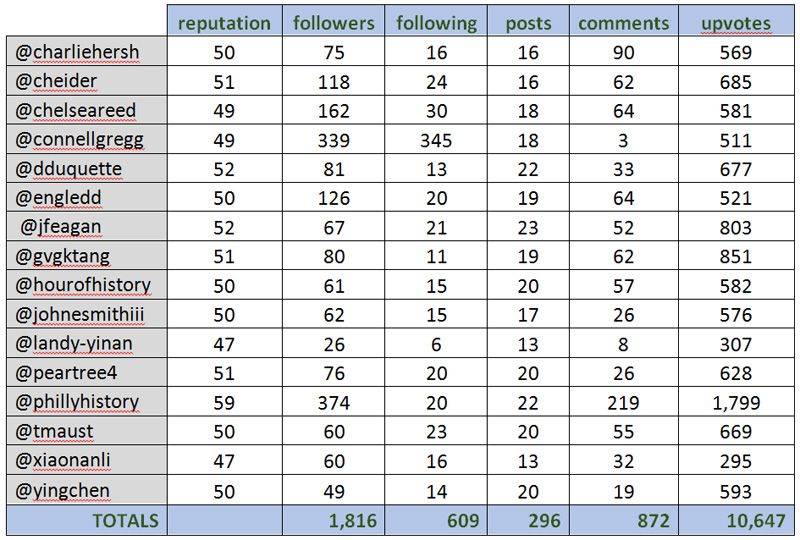 ## But it's much more than a numbers game. --- Quality content and meaningful discourse is at the heart of the educational mission of this project. As the semester comes to a close, we’ll present additional posts highlighting the most engaging and informative student work. And we’ll present the fate of this account and its accumulated assets. ## <center>Next Time: Some Remarkable Highlights</center> <sup>100% of the SBD rewards from this #explore1918 post will support the Philadelphia History Initiative @phillyhistory. This crypto-experiment conducted by graduate courses at Temple University's [Center for Public History](https://sites.temple.edu/centerforpublichistory/) and MLA Program, is exploring history and empowering education. [Click here](https://steemit.com/introduceyourself/@phillyhistory/announcing-the-first-steem-powered-university-course-mining-the-year-1918-at-temple-university) to learn more.</sup> --- <center>[](https://steemit.com/@phillyhistory)</center>
This week we @phillyhistory are faced with the hypothetical challenge of dispensing $10,000; $100,000; $1,000,000; and $10,000,000 to have maximum impact for public history. Here is my idea.  [image source](https://microgrants.net/about/) # Microgrants <h1> A microgrant is a small grant $2,000-10,000 to an individual or community organization for impact oriented project based on the model of microfinance pioneered by nobel laureate Muhammad Yunus through Grameen Bank in Bangladesh. Unlike much of microfinance and microcredit, microgrants need not be repayed in money, but rather through the production of public history.  *A microgrant could power the regeneration of historical production in places long detached from major corporations and cities. Prospective award recipients might team up with studies like [this one - image source](https://www.leverhulme.ac.uk/awards-made/awards-focus/beyond-havana-beyond-nation-peripheral-identities-and-literary-culture-cuba) that show there is literature beyond the city.* # How this works <h2> Depending on the size of the money available, an announcement would be sent out to public historians across the globe for prizes of various sizes- none greater than $10,000. That means if $10,000,000 was available for public history, **ONE-THOUSAND** promising projects would get $10,000 to bring public history to the world. If a smaller amount of money was available, like $10,000, the prizes would be split into fifty prizes of $200. The **goal** is to give as many public historians as possible a voice, with emphasis on developing nations and often ignored public histories. # The Selection Process <h3> Selecting between fifty and one-thousand winners is no small task. That is why the selection process would be run by an organization like [Spark](https://www.sparkmicrogrants.org/the-spark-model) who have experience with the use of microgrants in developing nations. Spark uses a locals-know-best approach where the grant winners are given freedom to use the grants how they see fit. Whereas a podcast might be the most useful way to reach an audience in the United States, using the grant for a public history project in Cuba might take a different form like radio or literature. Another potential method of the selection process is teaming up with an organization like the Peace Corps, who are currently active in 65 nations. Through these connections, grants could be selected, administered, and reported-on after completion. Finally, a call for applications online, while it might limit applicants, would still open the door to a world full of ideas and present a more manageable method of grant dispersal. # Potential Problems, Prospective Solutions <h4> You might be worried that $200 is not enough to make a significant contribution to public history. For public history in the United States, you might be correct. However, at an average monthly salary of $30 a month, Cubans would benefit greatly from such grants. A major issue in developing nations is that the public history, literature, and art is produced solely by the wealthiest citizens in the capital cities. However, microgrants would enable public historians to produce works away from the publishers and cities that dominate the established market. Rather than having another story published about the history of Havana, a city romanticized and fetishized by historians local and abroad, a microgrant would bring to light the public history of towns like Gibara, long forgotten after the departure of American multinational sugar companies. 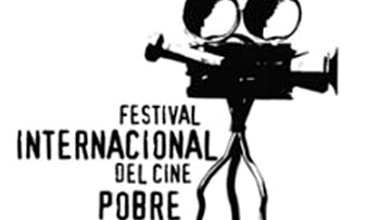 [CinePobre](http://cinepobre.org/), originally in Gibara, has grown in fame recently under the framework "that film becomes art only when its materials are as inexpensive as pencil & paper. Cine Pobre Film Festival is the 100% cartel-free intersection of culture and capabilities." It is just one example of how microgrants could change public history. Small grants won't only work in the developing world. With the proliferation of technology, a grant of two-hundred dollars could make the difference between quality recording and noisy nonsense in a burgeoning podcast. From personal experience, I know my podcast, [Hour of History](www.hourofhistory.com), could turn two-hundred dollars into equipment that professionalizes the sound and closes the gap between professionally produced media and the realities that public historians often have to contend with. 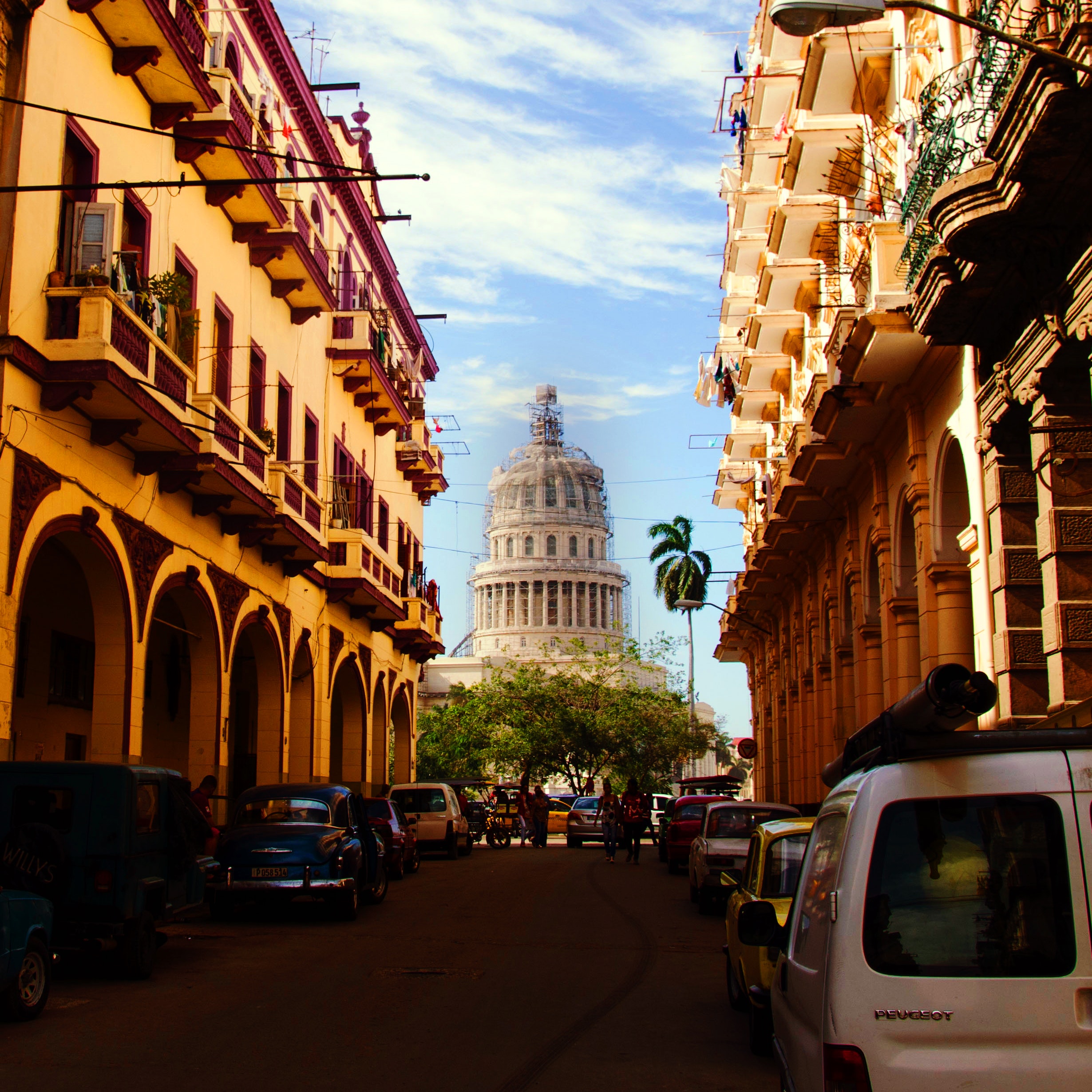 *Havana is beautiful and full of history, but places away from the city need only small grants to share their equally rich history.* # Discussion <h4> Is this the most democratic stewardship of money to improve public history? Is it too small to make a meaningful impact? Do we need more oversight in grant-giving and award monitoring? <sup>100% of the SBD rewards from this #explore1918 post will support the Philadelphia History Initiative @phillyhistory. This crypto-experiment conducted by graduate courses at Temple University's [Center for Public History](https://sites.temple.edu/centerforpublichistory/) and MLA Program, is exploring history and empowering education. [Click here](https://steemit.com/introduceyourself/@phillyhistory/announcing-the-first-steem-powered-university-course-mining-the-year-1918-at-temple-university) to learn more.</sup>
### What we’ve been reading, discussing & doing --- Here are some summaries from the [@Phillyhistory Feed]( https://steemit.com/@phillyhistory/feed) our twelfth week of the semester. 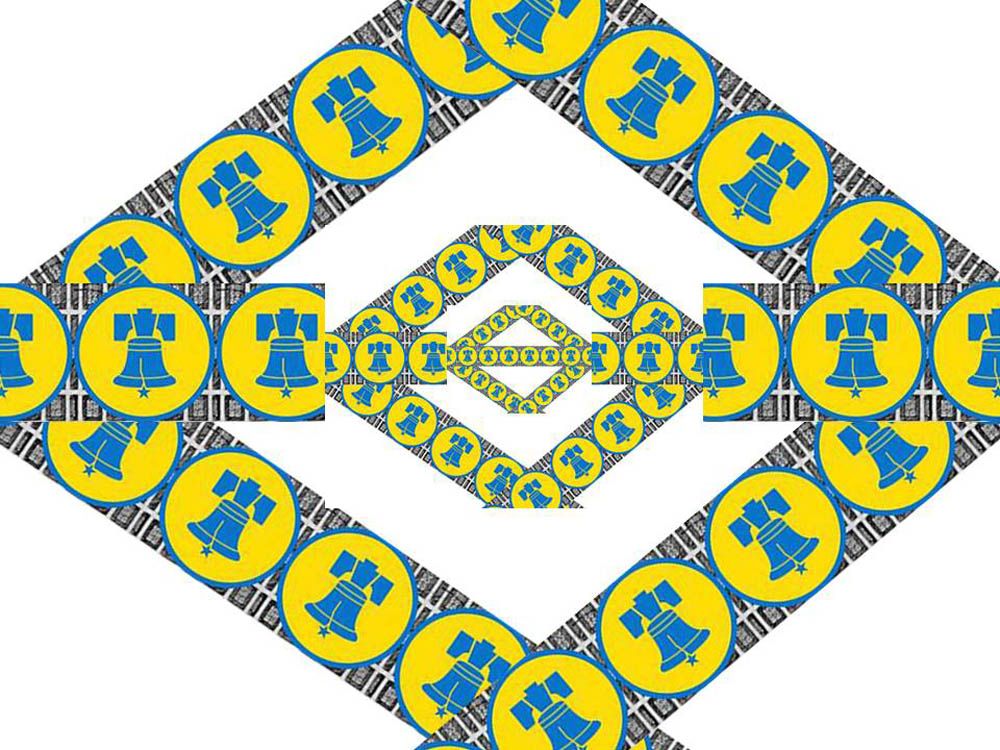 In [this thoughtful post,]( https://steemit.com/collaboration/@johnesmithiii/build-capabilities-not-projects) @johnesmithiii highlights from the reading [Like, Link, Share](http://likelinkshare.org/) “Digital innovation is sparking not only ‘cool new projects’ but also fundamental changes in the orientation of legacy institutions toward a more spirited public presence and a renewed sense of civic purpose.” This could “level the playing field and allow smaller institutions to reach broader audiences.” But what about shifting the conversation of digital strategy from individual institutions to the sector as a whole? “What if we witnessed cross-organizational collaboration more frequently?” he asks. “I think there is still greater potential for organizations to collaborate and build a stronger cultural ecosystem” leading “to stronger partnerships and a healthier interconnected system for research.” From @gvgktang we get a Wakelet collection of [PubComm 2018: A Recap](https://wakelet.com/wake/1f978f31-3049-421d-b0e0-1a3f4bcca751) full of good ideas and observations, about "Racism & Resistance" including “To understand freedom in America, you need to understand the trajectory of those who have been oppressed in American history. Those in power cannot define what freedom is,” (from @charliehersh) and “Public history is an opportunity to move beyond the ivory tower that pays my bills -@TukufuZuberi” (quoted by @tmaust). From @dduquette we read about the “noble goal” of “greater inclusion in the historical record.” “Panelists argued that the fruits of this labor never return to the communities that we as public historians seek to better represent. This led to questions… “about how cultural institutions and public historians can give what we learn back to those communities so that it can benefit them. One way of doing this is by ceding authority,” but Public Historians have “fallen short.” The answer? To “actually engage with, listen to, and utilize the testimonies from communities they want to represent in historic registers to do so in a more responsible way.” More on this [here]( https://steemit.com/explore1918/@dduquette/it-takes-a-village-to-represent-itself-how-community-centers-can-help-decentralize-cultural-nonprofits). And [here]( https://steemit.com/detroit/@cheider/present-perfect-public-history-the-future-of-audience-centered-cultural-organizations ) @cheider talks about “the 21st-century Identity Crisis of Cultural Organizations. (A crisis whose time has finally come to roost on the surface?) pointing out the link between “Cultural Heritage and Community Service.” She sees settlement houses as powerful models for museums which claim they “want to be more community-driven.” And for some [Adventures in Ethics]( https://steemit.com/history/@tmaust/adventures-in-ethics) we turn to @tmaust who enlightens us with an interesting quote from Thomas Jefferson: “"When a man assumes a public trust, he should consider himself as public property." (Ethics and gendered language aside, Jefferson *did* know something about people as property.) And we read that for all the ethical guidance, there’s nothing in it that tells us “how to operate (and survive!) independent of a market economy.” “Most of our lessons have been unsettling,” confides @jfeagan, who looks deeply at the job statistics in Philadelphia versus back home in St. Petersburg, Florida. The post concludes with a near-existential appeal: “Should I stay in the big city, or am I right to want to be a big fish in a smaller pond?” Nineteen hours in, there’s silence. What say you, Quakerdelphians? [Here’s]( https://steemit.com/moving/@jfeagan/on-being-a-different-sized-fish-in-different-sized-ponds-where-should-i-live-after-graduation) where to chime in. And, finally (for now, anyway) @dduquette offers a somewhat heated response to the question [What Do We Do If No One Applies For Our Funds?](https://steemit.com/explore1918/@dduquette/plan-b-what-do-we-do-if-no-one-applies-for-our-funds). Some good thinking proposing to build on current momentum and understanding of the city’s many LGBTQ+ historic sites. ### <center> Please share your your opinions and insights with us.</center> --- <sup>100% of the SBD rewards from this #explore1918 post will support the Philadelphia History Initiative @phillyhistory. This crypto-experiment conducted by graduate courses at Temple University's [Center for Public History](https://sites.temple.edu/centerforpublichistory/) and MLA Program, is exploring history and empowering education. [Click here](https://steemit.com/introduceyourself/@phillyhistory/announcing-the-first-steem-powered-university-course-mining-the-year-1918-at-temple-university) to learn more.</sup> <center>**Please follow, upvote, resteem and keep track as the course progresses.**</center> --- <center>[](https://steemit.com/@phillyhistory)</center>
Now we are seven. We’re down to seven projects, that is. And each of the home organizations will soon receive a version of the email below. Before we hit the “send” button, does anyone have any corrections, suggestions, tweaks? 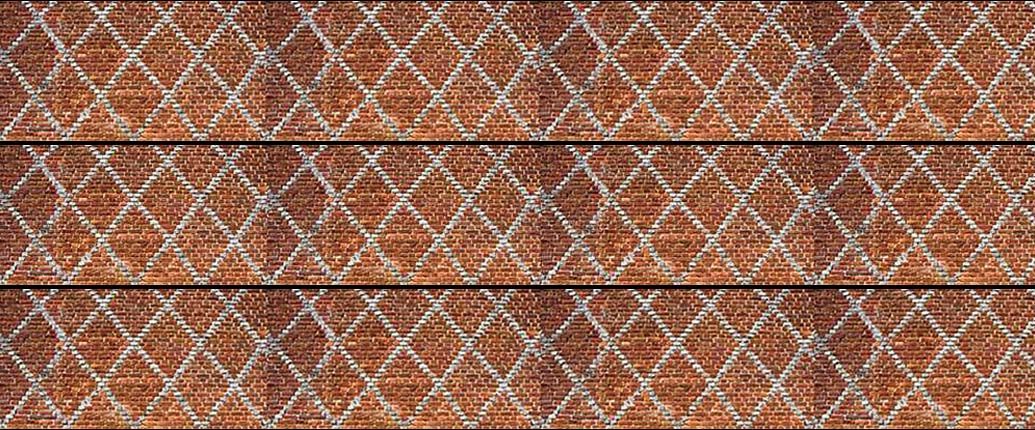 Now we are seven. We’re down to seven projects, that is. And each of the home organizations will soon receive a version of the email below. Before we hit the “send” button, does anyone have any corrections, suggestions, tweaks? ### This is how the first contact (via email) will read: --- Dear_____ My name is Kenneth Finkel and I’m a professor of history at Temple University. This semester, my graduate class in public history (Nonprofit Management for Historian) has been working on an innovative project to raise funds for projects in public history. So far this semester we have successfully raised the equivalent of more than $6,000. Fifteen students have considered where these funds might be needed and where they would do the most good. After weeks of discussions we have narrowed down the possibilities to seven possible recipients, including your organization. Specifically, the project proposed by [STUDENT NAME] is: [PROJECT DESCRIPTION] If your organization is interested in pursuing this offer, please let me know as soon as possible. The next step would be our request for your response to questions in order to help us compare and choose the recipient. We intend to make our award before the end of April. If you are interested, I will provide you with a thorough explanation of the project and the source of funds. (Briefly, we have been raising funds in the form of STEEM on [Steemit](https://en.wikipedia.org/wiki/Steemit), a new social media platform that utilizes blockchain technology. You can see our main project page here: https://steemit.com/@phillyhistory. We hope to hear from you shortly with positive news about your interest in participating. Sincerely, KF ### Your feedback? Should anything be edited; anything more to be added? --- <sup>100% of the SBD rewards from this #explore1918 post will support the Philadelphia History Initiative @phillyhistory. This crypto-experiment conducted by graduate courses at Temple University's [Center for Public History](https://sites.temple.edu/centerforpublichistory/) and MLA Program, is exploring history and empowering education. [Click here](https://steemit.com/introduceyourself/@phillyhistory/announcing-the-first-steem-powered-university-course-mining-the-year-1918-at-temple-university) to learn more.</sup> <center>**Please follow, upvote, resteem and keep track as the course progresses.**</center> --- <center>[](https://steemit.com/@phillyhistory)</center>
### Class is cancelled today (*snow!*), but we’re moving along in several ways as we have seven projects to consider: --- • Create Paid Internships at Art-Reach (proposed by @charliehersh) • Develop Community Led Oral Histories (@gvgktang) • Fund the Fund for the School District of Philadelphia (@hourofhistory) • Support the Philadelphia Black History Collaborative (@chelseareed) • Advance the Pennhurst Memorial & Preservation Alliance’s Museum and Interpretive Center (@dduquette) • Develop Walking Tours that are Free, Relevant and Engaging (@engledd) • Teach the Creatives of Today How to Fish in Tomorrow's Pools (@peartree4) Unfortunately, we’re now missing the Public History Truck. It’s founder had to decline to participate: "I do not have the manpower to make the project your students proposed come to fruition—however, it is a compelling idea, one that I had played around with at the end of the 2015 exhibition They Say They Gonna Build when the stadium rumblings began.” (I shared the full response with @johnesmithiii, who would have been the main contact if we were to go ahead with this one.) Also, in the spirit of leveraging the potential power of the STEEM platform, and deploying my discretion as professor, I chose to include “Teach the Creatives of Today How to Fish in Tomorrow's Pools.” 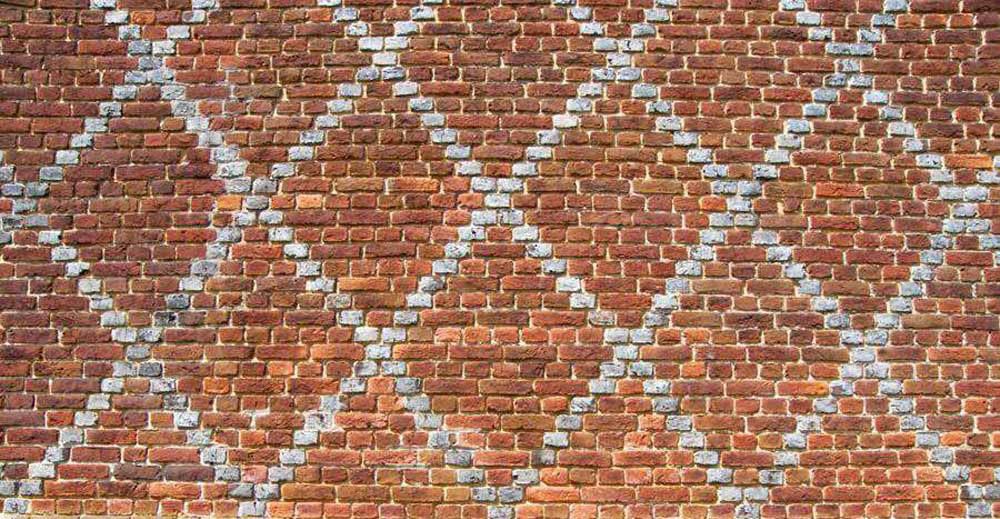 ### What's next for our seven prospects? --- Direct contact. Now is the time for each of the students listed next to the bulleted projects above to send me (via email) contact information for the organization and a short description of the proposed project. I will then send each a description of our project and ask if they are willing to submit a response and a request for the STEEM by April 13. We will be requesting answers to the following questions which align with our evaluation criteria: • Is the proposed organization willing and able to commit? • Is the proposed project consistent with their mission? • Will additional resources be leveraged? • Will the organization continue to utilize Steemit? • Will the project continue after the funding runs out? • Is there a reasonable promise of scale and impact? • Will the project be community driven or community oriented? • Will the project provide increased, affordable access? I will also explain the Steemit process, letting the organization know the step-by-step sequence of events to transfer funds after the award decision. (More on that in a subsequent post.) ### Then, in mid-April, with responses in hand, we’ll make a funding decision. --- <sup>100% of the SBD rewards from this #explore1918 post will support the Philadelphia History Initiative @phillyhistory. This crypto-experiment conducted by graduate courses at Temple University's [Center for Public History](https://sites.temple.edu/centerforpublichistory/) and MLA Program, is exploring history and empowering education. [Click here](https://steemit.com/introduceyourself/@phillyhistory/announcing-the-first-steem-powered-university-course-mining-the-year-1918-at-temple-university) to learn more.</sup> <center>**Please follow, upvote, resteem and keep track as the course progresses.**</center> --- <center>[](https://steemit.com/@phillyhistory)</center>
 Free Tours by Foot 20 N 3rd St Ste 201, Mailing Address Only, Philadelphia, PA 19106-2118 https://freetoursbyfoot.com/philadelphia-tours/ ***Great Ideas, and concepts organization currently provides/have -Currently they provide pay what you want -They already provide post colony tours, some of these tours include; Italian Market, Chinatown, Mural Project, and The Good, The Bad, The Philly-Logan Circle -Diverse background of tour guides Good Afternoon Free Tours by Foot Philadelphia, My name is Gregg Connell, and I am pursuing a Master of Liberal Arts from Temple University. I currently am taking MLA 5220 - The Urban Cultural Ecology: Old and New Models of Sustainability. The course has been involved in an experimental new process, involving cryptocurrency, and raising money for a local Philadelphia Organization. Currently we have raised approximately $10,000 dollars in the crypto currency. The crypto currency used is called Steem. Here is a link to the blog/crypto currency website https://steemit.com/. The crypto currency we have produced is created by posting blogs about historical elements in Philadelphia and elements related to the year of 1918. The blogs then produce Steem currency which has a U.S. dollar value if sold. We have compiled a list of possible organizations to donate the cryptocurrency Steem to. The goal of this donation would be to provide a historical, artistic, or educational organizations with resources to better Philadelphia. One of my colleagues proposed a great idea of providing free walking tours to local schools. They raised two significant concerns. The first was the limited history provided by most Tour Groups about Philadelphia after the Colony Era. After researching your tour group, we found you cover a vast area of Philadelphia History. The second issue brought up, was the high cost of tours for the local school districts. Once again, after in-depth research, your pay what you want concept, provided a great opportunity for many to experience Philadelphia History at a cost determined by the individual. While donating this money could pay for local walking tours of local students, we comprised what we believe could be a better plan. The plan would include creating a local historical walking tour, which would provide the material, routes, and history needed for teachers to provide the tours directly to their students. Your website provided great information on your diverse tour guides backgrounds. We feel, that with your help, we could create a program to distribute to local schools. Would your team be interested in pursuing our mission? Thank you for your time, Look forward to hearing from you, Gregg Connell
### Decision Time Approaches Thanks to our collective teamwork, we now have two essential lists: 1) Nonprofit organizations, candidates capable of implementing projects with the 3000 STEEM we’ve accumulated, and 2) Criteria by which we will compare and decide which one organization will receive the STEEM.  Now’s the time for us to reach out to the candidates and determine how willing and able they are to work with us. Then, when we have all of their responses, we will hold in-depth discussions and select a recipient. ### 3,000 STEEM Awaits the Selected Organization. Over the past two-to-three weeks ago we developed project ideas. In the past week, we’re developed criteria for ranking them. But there’s still a LOT we don’t know. Do the potential recipients see our ideas as consistent with their own missions? Do they truly have the capacity to implement what we propose? Will they bring other resources into play? We have these and many other questions to answer to get to a point where we are comparing projects like, as they say, apples to apples. 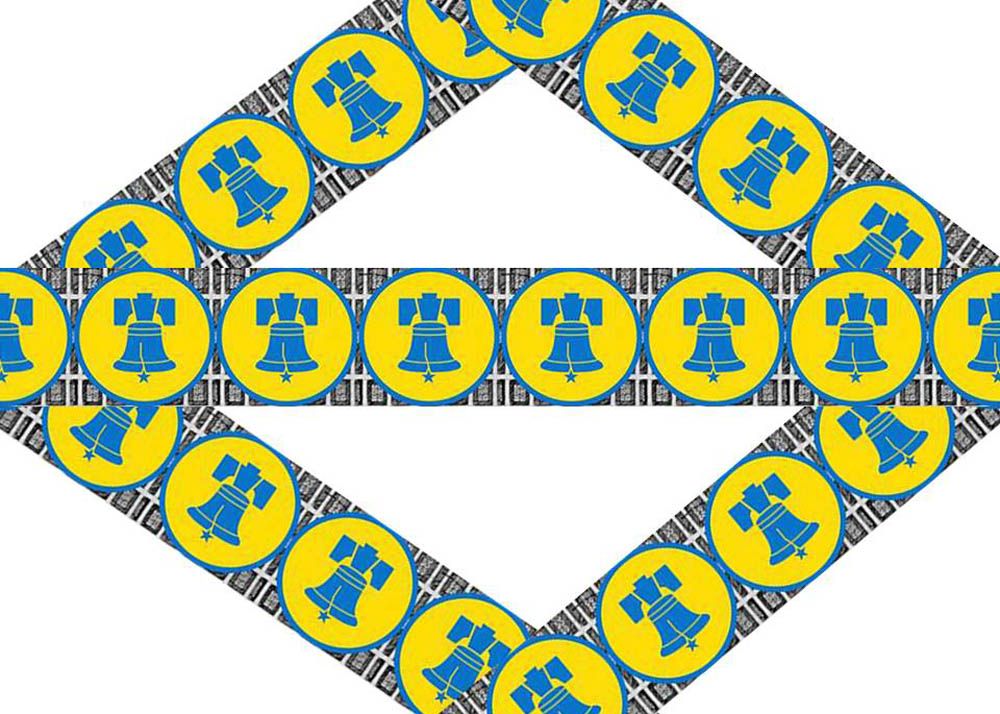 ### It’s an experiment in crypto-philanthropy that promises transparency, innovation, engagement. Below are the projects that we’d like to see happen. If we had the resources, we’d want to fund each of them in some way. But we don’t and we can’t. We need to select one. So what will happen next? Our team members (students) will contact the nonprofits associated with each of these project ideas presented and ask them to respond to a series of questions. • [Create Paid Internships at Art-Reach]( https://steemit.com/life/@charliehersh/making-the-cultural-sector-more-accessible-from-the-bottom-up) • [Deploy the Public History Truck to Document the Temple Stadium Project]( https://steemit.com/loi2018/@johnesmithiii/funding-a-mobile-museum-the-philadelphia-public-history-truck) • [Develop Community Led Oral Histories]( https://steemit.com/nonprofits/@gvgktang/the-personal-is-political-is-historical-an-loi) • [Fund the Fund for the School District of Philadelphia]( https://steemit.com/loi2018/@hourofhistory/letter-of-intent-schools-are-the-future-of-history) • [Support the Philadelphia Black History Collaborative]( https://steemit.com/explore1918/@chelseareed/identifying-philadelphia-s-history-needs-missing-narratives-in-k-12-classrooms) • [Advance the Pennhurst Memorial & Preservation Alliance’s Museum and Interpretive Center]( https://steemit.com/loi2018/@dduquette/letter-of-intent-preserving-the-memory-of-pennhurst) • [Develop Walking Tours that are Free, Relevant and Engaging](https://steemit.com/history/@engledd/a-tour-through-the-past) • [Teach the Creatives of Today How to Fish in Tomorrow's Pools]( https://steemit.com/loi2018/@peartree4/feed-a-starving-artist-school-them-in-blockchain-part-2) 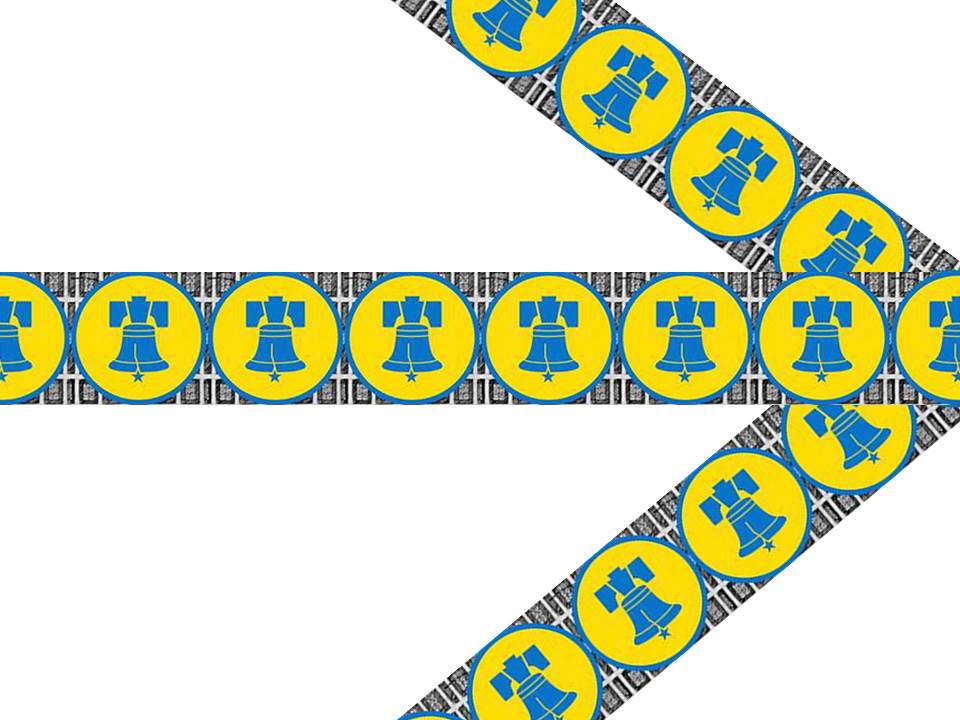 ### Here are the questions for potential recipients based on the criteria we developed: • Is the project a good fit for your organization’s mission? • Does your organization have the desire and capacity to implement the project? • Will the implementation of the proposed project leverage additional resources? • It the project community driven? • Does the project promise community impact? • Will the project have scale and/or sustainability? • Will your project increase access? Will that access be affordable? Last, but not least, since the winning organization will receive 3,000 STEEM generated with our Steemit accounts, we will urge the winning organization to commit to continue on Steemit, blogging to get the word out and continuing to accumulate additional resources. Will they? ### The Schedule March 19-22: Initial contact made with prospective organization March 23-April 6: Follow-up contact; Q & A April 13: Response Deadline April 16-18: Deliberation April 19: Decision Announcement ### Upcoming Posts: - FAQ for the Finalists - Your Organization Received an Award for 3,000 STEEM. Now What? - Imagine: Philadelphia’s Cultural Community Going Full Steem - Profiles of the Finalists --- <sup>100% of the SBD rewards from this #explore1918 post will support the Philadelphia History Initiative @phillyhistory. This crypto-experiment conducted by graduate courses at Temple University's [Center for Public History](https://sites.temple.edu/centerforpublichistory/) and MLA Program, is exploring history and empowering education. [Click here](https://steemit.com/introduceyourself/@phillyhistory/announcing-the-first-steem-powered-university-course-mining-the-year-1918-at-temple-university) to learn more.</sup> <center>**Please follow, upvote, resteem and keep track as the course progresses.**</center> --- <center>[](https://steemit.com/@phillyhistory)</center>
### It’s time to rank our top 10 project ideas for funding. --- In two recent posts - [this one](https://steemit.com/philanthropy/@phillyhistory/five-project-ideas-which-one-rises-to-the-top) and [this one](https://steemit.com/philanthropy/@phillyhistory/five-project-ideas-which-one-rises-to-the-top) - we presented summaries of ten interesting project ideas proposed by graduate students in public history. The purpose: to invest 3,000 STEEM in a quality program of value. ### But how to make a decision that is both objective and fair? ---  This week, the two classes debated and developed criteria for funding based on their values and priorities and then assigned scores on a scale of 1 to 5 for each. When there wasn't enough information to judge, a score of 2.5 was assigned. Here's the list of criteria from Monday's class (5220): - Is the project Crypto/Tech Savvy? - Will it Increase Access to Cultural Resources? - Will it Leverage additional Resources? - Does the Organization have the Capacity to Implement - Will the Project Have Impact on the Community or on the Organization? And here is the list from Wednesday's class (5151): - Will the Project leverage STEEM and/or Other Resources? - Feasibility. Can the organization implement the project with existing infrastructure and human capital? - Will the Project Enable Accessibility and Affordability - It is Community Driven? Does it Fit the Mission of the implementing Organization? - Is the Project Topical? / Does it promise scale or Impact? ### A Glimpse at the Process: Some of the Results on the Whiteboard: 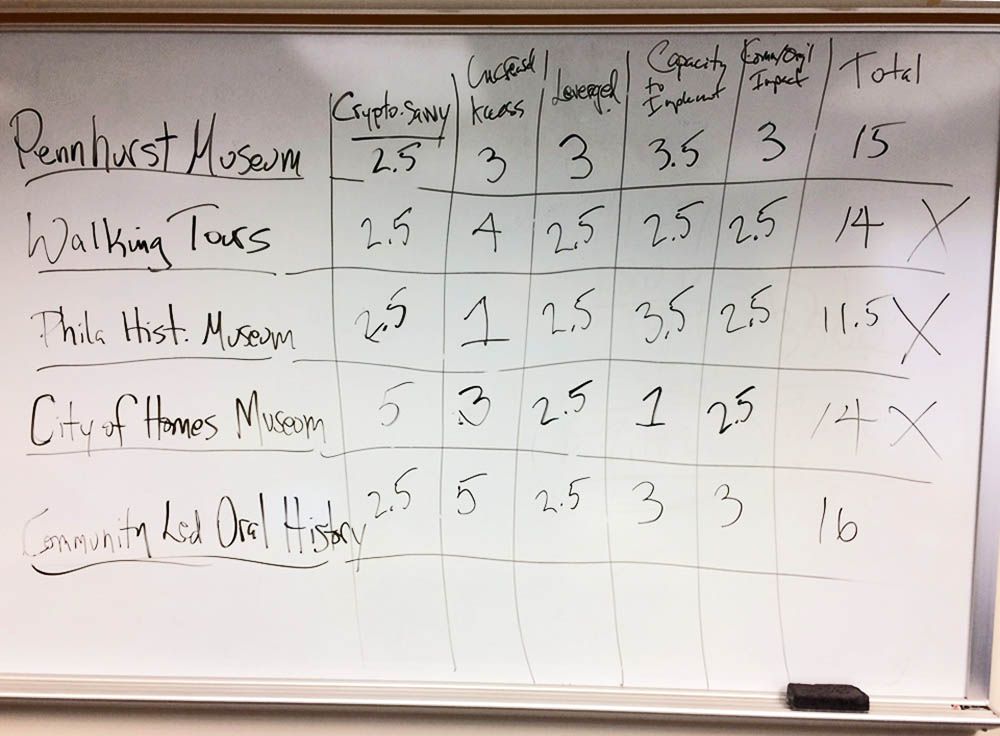 It is important to note that these two lists of criteria were developed independent of one another. Interesting, too, is how they are somewhat the same, yet not entirely. For instance, one class put a priority on what they called "Crypto/Tech Savvy." The other class valued accessibility and affordability. Both classes ranked Art Reach and the Public History Truck highly. Both gave thumbs down to funding transition costs at the Philly History Museum and the new City of Homes Museum. But there was significant disagreement about "Teaching Creatives of Today How to Fish in Tomorrow's Pools" and "Funding the Fund for the School District of Philadelphia." Here's the combined rankings from both classes: 1. Create Paid Internships at Art-Reach 2. Deploy the Public History Truck to Document the Temple Stadium Project 3. Community Led Oral Histories 4. Fund the Fund for the School District of Philadelphia 5. Support the Philadelphia Black History Collaborative 6. The Pennhurst Memorial & Preservation Alliance’s Museum and Interpretive Center 7. Walking Tours that are Free, Relevant and Engaging 8. Plan a New Museum for the “City Of Homes” 9. Teach the Creatives of Today How to Fish in Tomorrow's Pools 10. Invest in the Future of History by supporting transition costs at the Philadelphia History Museum Assuming there is wisdom here, and we believe there is, we want to explore the possibilities of most of the proposals, leaving off City of Homes and the History Museum, which both classes ranked low by both classes. (Interesting that of these two, one is a traditional public history institution and the other is a traditional approach to public history.) 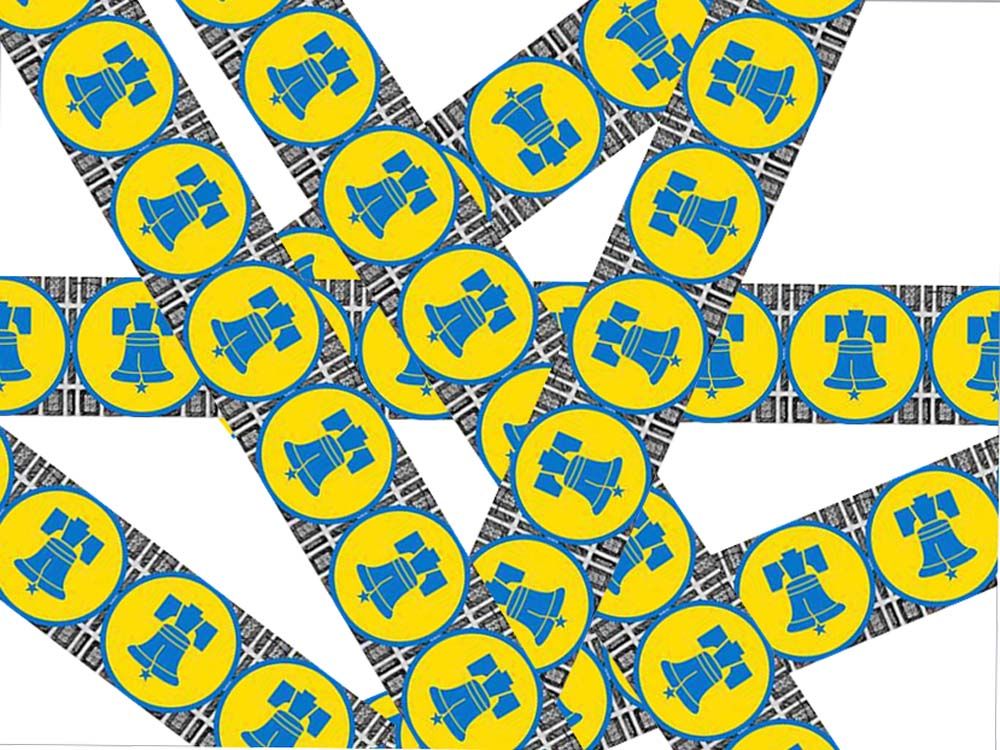 ### <center> Next Steps? Reaching out to the organizations themselves. Will they want to accept the funds and implement these proposed projects?</center> --- <sup>100% of the SBD rewards from this #explore1918 post will support the Philadelphia History Initiative @phillyhistory. This crypto-experiment conducted by graduate courses at Temple University's [Center for Public History](https://sites.temple.edu/centerforpublichistory/) and MLA Program, is exploring history and empowering education. [Click here](https://steemit.com/introduceyourself/@phillyhistory/announcing-the-first-steem-powered-university-course-mining-the-year-1918-at-temple-university) to learn more.</sup> <center>**Please follow, upvote, resteem and keep track as the course progresses.**</center> --- <center>[](https://steemit.com/@phillyhistory)</center>
### It's time to design a decision grid. --- We have many ideas, good ones, and they are before us in posts on the [PhillyHistory feed]( https://steemit.com/@phillyhistory/feed), summarized [here]( https://steemit.com/philanthropy/@phillyhistory/five-project-ideas-which-one-rises-to-the-top) and [here](https://steemit.com/philanthropy/@phillyhistory/five-project-ideas-which-one-rises-to-the-top).  Now’s the time to look at them more closely and systematically. Seems easy at first, but we have 15 voices and perspectives, personal insights and professional experience, firmly-help opinions and ambitions in play. How to sort it all out and come up with the most thoughtful – the best – recommendation? Reading over the comments, we find a lot of concerns. Here are a just few: - “I'm worried that our money wouldn't be enough to develop a concrete, effective action." - "The only concern would be how to facilitate this plan?" - "I am concerned about the longevity of it." - "I just don't think we have enough funds." - "We need to ask what sustainability might mean." - "We need to avoid placing new programming obligations on organizations." - "Will our donations provide enough funds to help push this program forward, and cover all bases needed?" - "I'm still worried that this would be very hard without the help of some whales." ### Yes, now’s the time to apply some systematic thinking. --- What criteria would be appropriate to use to begin our evaluation? What measures could we agree upon? Over the last month or so, we’ve talked about concepts and measures of organizational effectiveness embodied in many words: capacity, ability, experience, viability, sustainability, quality, and readiness, to mention but a few. Now is the time to select five criteria that most clearly enable us to compare apples and apples (or as close to apples as possible) and accomplish what seems to be ever-more elusive: a good funding decision. That’s what we’re going to be talking about today, using these two forms: 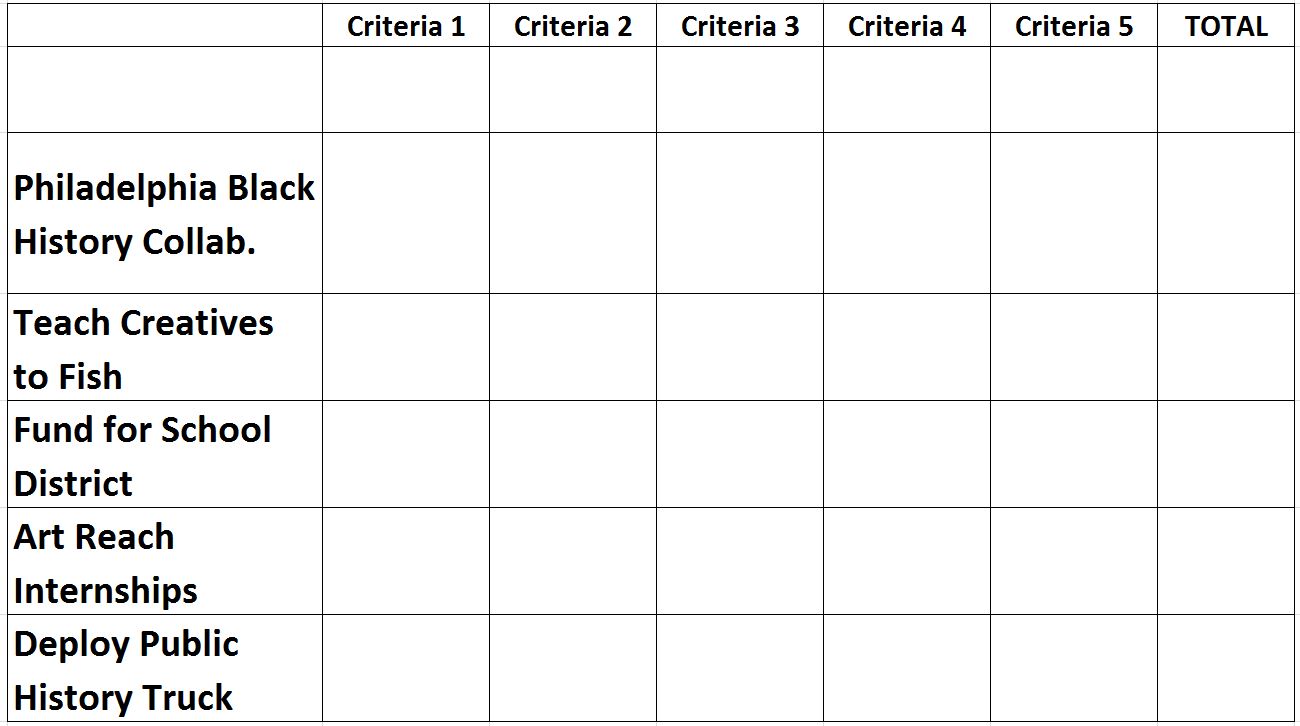 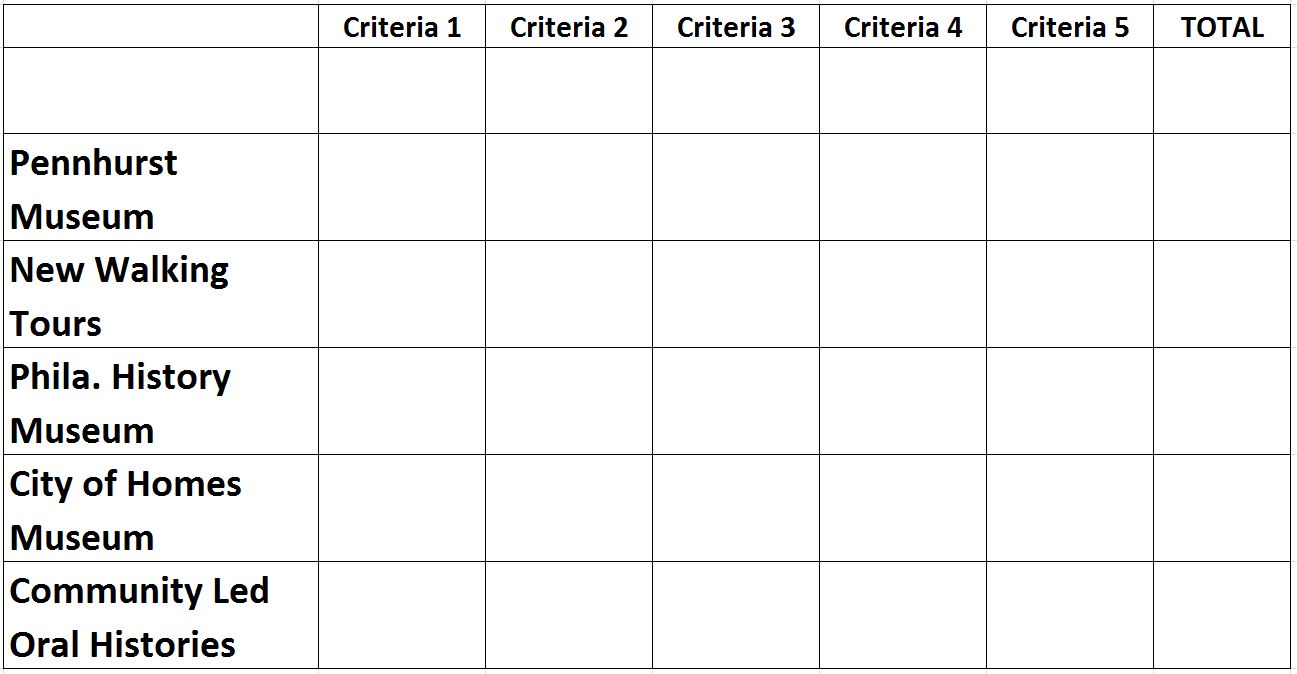 Where will we be when we’ve filled out our grids? Where will we be having graded each project idea and each criteria on a scale of 1 to 5 (assigning 2.5 when we have no information)? We *should* be able to remove the least likely projects and make focused inquiries about the rest. Sounds like a plan? But what five criteria should we use? ### We need to hear what you think. --- <sup>100% of the SBD rewards from this #explore1918 post will support the Philadelphia History Initiative @phillyhistory. This crypto-experiment conducted by graduate courses at Temple University's [Center for Public History](https://sites.temple.edu/centerforpublichistory/) and MLA Program, is exploring history and empowering education. [Click here](https://steemit.com/introduceyourself/@phillyhistory/announcing-the-first-steem-powered-university-course-mining-the-year-1918-at-temple-university) to learn more.</sup> <center>**Please follow, upvote, resteem and keep track as the course progresses.**</center> --- <center>[](https://steemit.com/@phillyhistory)</center>
### It’s time to debate the PROS and CONS of our top 10 ideas. --- In this post and [yesterday’s](https://steemit.com/philanthropy/@phillyhistory/five-project-ideas-which-one-rises-to-the-top) we present a total of ten summaries of project ideas proposed by graduate students in public history. The purpose: to decide how to invest in the missions of nonprofit organizations. What are we investing? We have accumulated STEEM since January. ### In all, we have about 3,000 STEEM to invest in community. --- 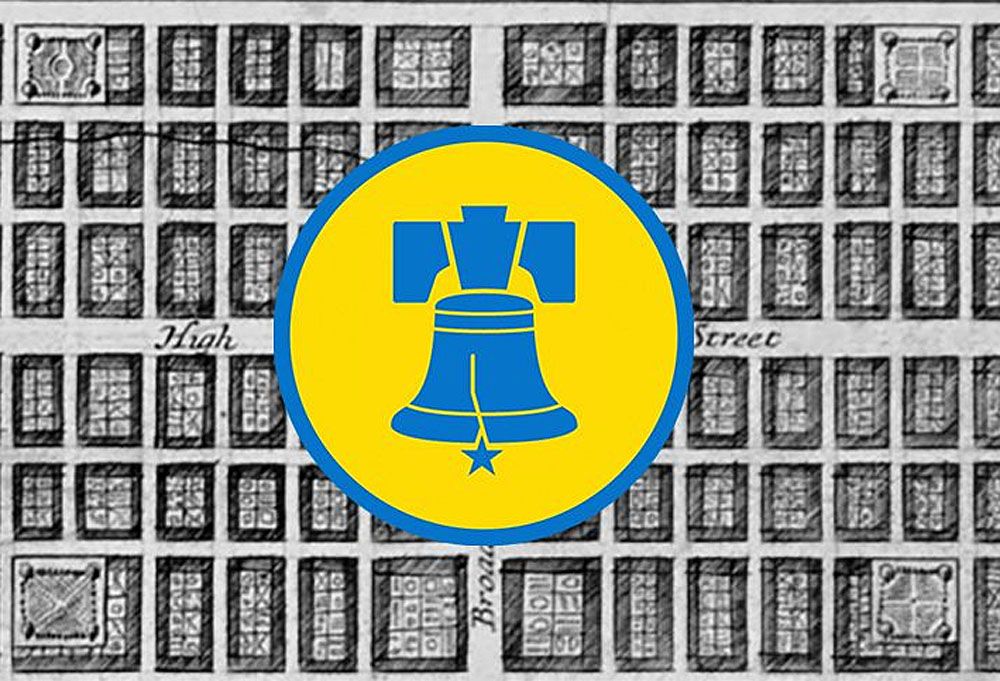 Over the next weeks, we’ll be debating online and in class which one of these projects is the most desirable, achievable and impactful. We’ll want to know which promises to leverage additional resources. Which one represents the best investment for this course and for the community? Here are the second five of the ten project ideas: ### The Pennhurst Memorial & Preservation Alliance’s Museum and Interpretive Center This center will present and educate local, regional and international visitors about the underrepresented History of Intellectual and Developmental Disability. The project at this vintage, authentic site includes restoring an early twentieth century building, the creation of seven exhibits, and the first opportunity for visitors to legally visit the Pennhurst campus and learn its true history. Learn more [here.](http://www.preservepennhurst.org/default.aspx?pg=6)  ### Walking Tours that are Free, Relevant and Engaging The vast majority of Philadelphia’s walking tours are for profit, centered in Old City and tell similar stories focused on colonial Philadelphia. They neglect Philadelphia history after the colonial era, and are too expensive for most local schools to afford. The Philadelphia nonprofit sector should develop free local history walking tours and then disseminate the tour materials to teachers so they can run tours for their students.  ### Invest in the Future of History Support transition costs as the Philadelphia History Museum considers an alliance with Temple University. This would provide the opportunity for reconsideration and reorganization of the museum's mission and programs. Aligning with a major research, Philadelphia-based university would set the stage for mutually beneficial collaborations between the museum staff, collections, students, faculty and public.  ### Plan a New Museum for the “City Of Homes” To many residents of the City of Brotherly Love, the Philadelphia Row House is more iconic than Independence Hall. For more than a century, Philadelphia has also been known as the City of Homes, most of which are row houses built between the mid-19th century and the mid-20th century. This project proposes the founding of a new Row Home Museum in an authentic row house. This 21st-century historic house museum would include an exhibit space and become a community asset in one of the city’s many row house neighborhoods.  ### A Community-Led Oral History Project Support three organizations, [Art Sanctuary](http://artsanctuary.org/content/about-art-sanctuary), [Juntos](http://vamosjuntos.org/about-us/) and [Asian Americans United](http://aaunited.org/about/) to develop a collective, community-led oral history project. By engaging civic-minded organizations of color (within as well as outside of the arts and culture sector) in a collaborative public history project, we would not only draw connections between the academy and the public at large, but also between disenfranchised populations themselves. Funds would also provide much needed operating support. --- ### What projects do you consider the best investment? As we asked at the conclusion of [yesterday’s post](https://steemit.com/philanthropy/@phillyhistory/five-project-ideas-which-one-rises-to-the-top), consider each of the ten proposed projects. Explain then rank the projects in your replies. ### <center> Please share your your opinions and insights with us.</center> --- <sup>100% of the SBD rewards from this #explore1918 post will support the Philadelphia History Initiative @phillyhistory. This crypto-experiment conducted by graduate courses at Temple University's [Center for Public History](https://sites.temple.edu/centerforpublichistory/) and MLA Program, is exploring history and empowering education. [Click here](https://steemit.com/introduceyourself/@phillyhistory/announcing-the-first-steem-powered-university-course-mining-the-year-1918-at-temple-university) to learn more.</sup> <center>**Please follow, upvote, resteem and keep track as the course progresses.**</center> --- <center>[](https://steemit.com/@phillyhistory)</center>
### It’s almost time to make a decision. --- Students have proposed project ideas after considering the needs and the capacity of the cultural community. Below are half (five) for discussion and ultimately, a decision. Read them; consider them. What should be our criteria for making a decision? Register your thoughts. That’s what we’ll be discussing when we return to class next week.  ### [Supporting The Philadelphia Black History Collaborative](https://www.facebook.com/groups/BlackhistoryPHL/) Upon witnessing the flaws within the city’s current African American history curriculum, activist educators of color came together to fight for “the legacy of self-determination and the righteous study of Black history in our city and across the nation.” Through the volunteer work of their planning board and a self-initiated fundraiser campaign, they host professional development seminars and curriculum building workshops for African American history teachers throughout the city. Despite a lack of support from the Philadelphia School District, they sponsored the Black Lives Matter in Schools Week of Action. Funds to the Collaborative would fund the advancement of more engaging, relevant, and critical black history in Philadelphia. ### [Teach the Creatives of Today How to Fish in Tomorrow's Pools](https://steemit.com/loi2018/@peartree4/feed-a-starving-artist-school-them-in-blockchain-part-2) Funding programs and brick and mortar buildings is so 20th century. It's time we start playing with 21st century paradigms like the attention economy and fund people and engaged communities of practice. Create a program to train creatives how to leverage Steemit and blockchain technology to build a bigger audience and create new revenue streams. Teach them how to fish in tomorrow's pools to advance sustainability. Building a community of practice on blockchain platforms like Steemit offers a new revenue stream, a dynamic peer group, and an expanded audience. By piloting a blockchain literacy program for artists, at [In Liquid]( https://inliquid.org/about/), [The Woodmere Museum]( https://woodmereartmuseum.org/about) or [The Painted Bride]( https://paintedbride.org/about-us/), the Philadelphia community can demonstrate innovate ways to nurture our creative economy and culture. ### Support a Valuable Program Inside Public Schools Fund [The Fund for the School District of Philadelphia](http://thefundsdp.org/), whose mission is to “identify, coordinate and connect philanthropic resources—through effective public-private partnerships—to leverage investments in local public schools. We target strategic priorities that have a measurable impact on the success of students regardless of zip code, family income or chance. … By turning our resources over to The Fund, we would have supported a valuable program to grow inside the Philadelphia Public Schools. ### Create Paid Internships [Art-Reach](https://www.art-reach.org/) works to increase access to the cultural sector, particularly for low-income and disabled people. In the last year their programs have served over 160,000 people. They offer a variety of internships, but they are unpaid and thus create barriers for students within their target audience to become involved. With funding these can become paid internships specifically for low-income and/or disabled students, with the goal of supporting subsequent careers in the arts. ### Deploy The Public History Truck to Document the Temple Stadium Project Temple University has plans to construct a football stadium along north Broad Street, another example of the school's expansion into the local community. Support [The Philadelphia Public History Truck]( https://phillyhistorytruck.wordpress.com/), winner of the 2016 Outstanding Public History Project award, to archive this moment in time and collect personal memories from the local community. The Public History Truck can augment the narrative regarding the university's expansion and humanize the impact it has on the local residents. --- ### <center>What does it take for a project to rise to the top?</center> --- Consider each of the proposed projects in several different ways. Is there the organizational will and capacity to implement? Does the proposed project promise quality results? Would it be considered a good investment in terms of community impact? Is now the right time to implement? Will the project leverage additional resources now or in the future? How would you rank the projects using this and additional criteria? ### <center>*Come back tomorrow to learn about another five project ideas.*</center> --- <sup>100% of the SBD rewards from this #explore1918 post will support the Philadelphia History Initiative @phillyhistory. This crypto-experiment conducted by graduate courses at Temple University's [Center for Public History](https://sites.temple.edu/centerforpublichistory/) and MLA Program, is exploring history and empowering education. [Click here](https://steemit.com/introduceyourself/@phillyhistory/announcing-the-first-steem-powered-university-course-mining-the-year-1918-at-temple-university) to learn more.</sup> <center>**Please follow, upvote, resteem and keep track as the course progresses.**</center> --- <center>[](https://steemit.com/@phillyhistory)</center>